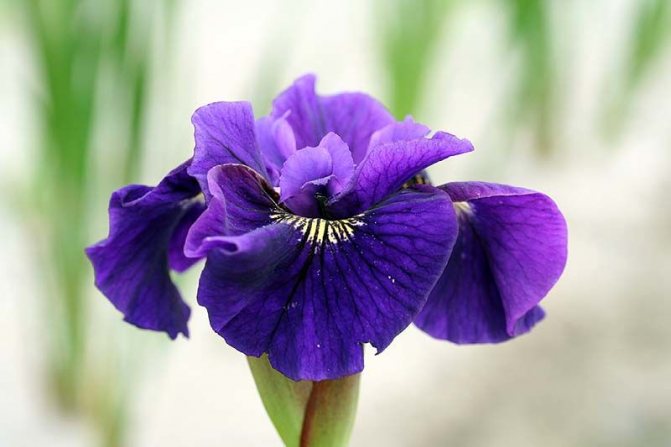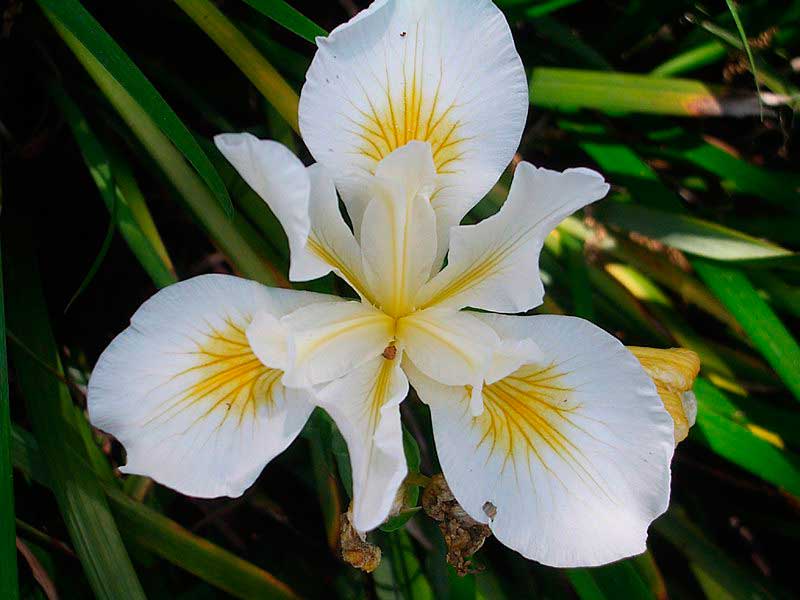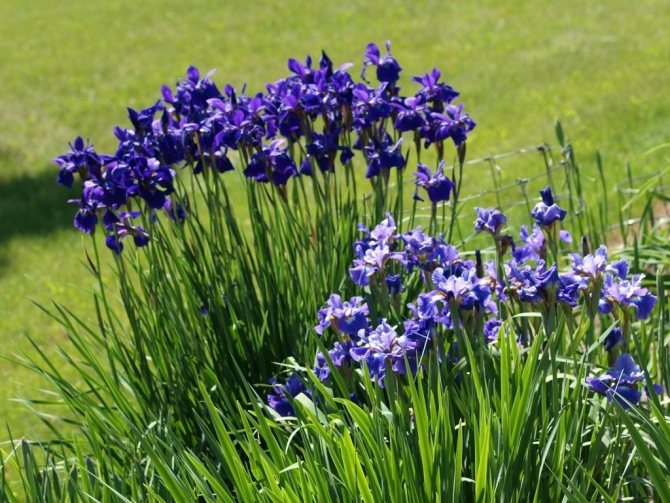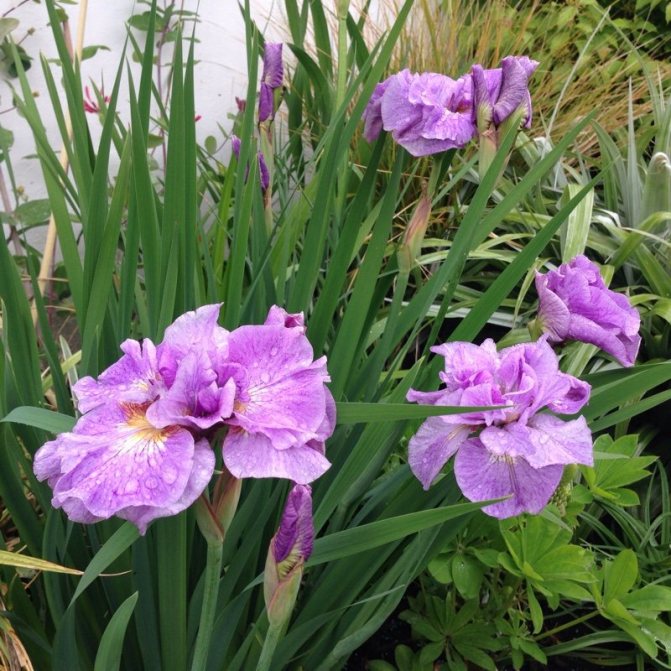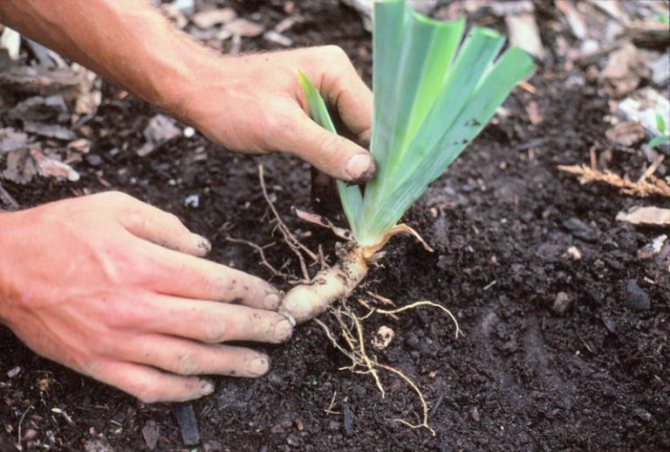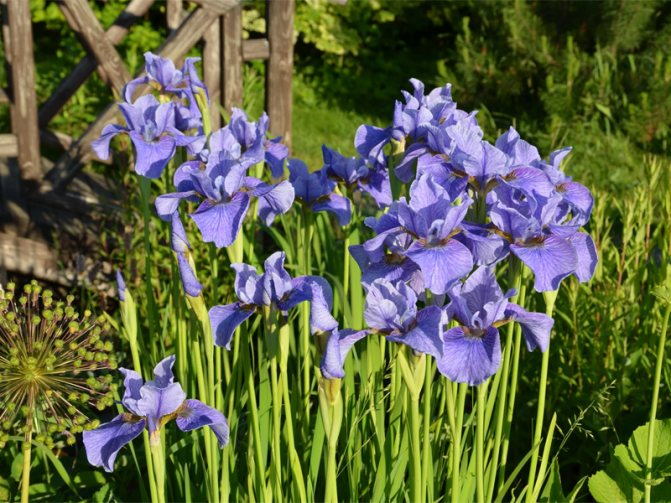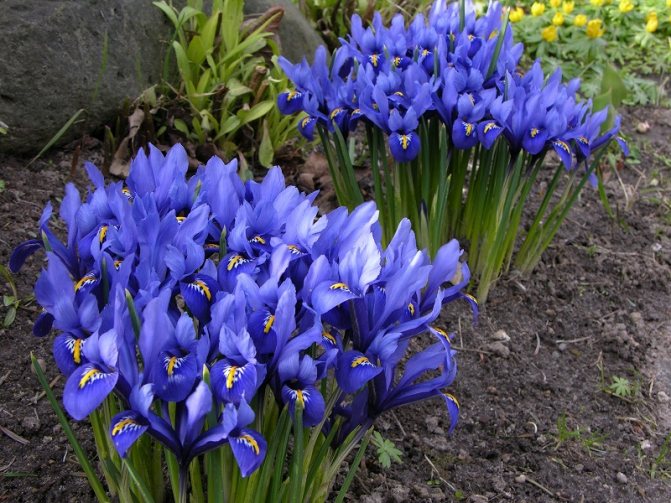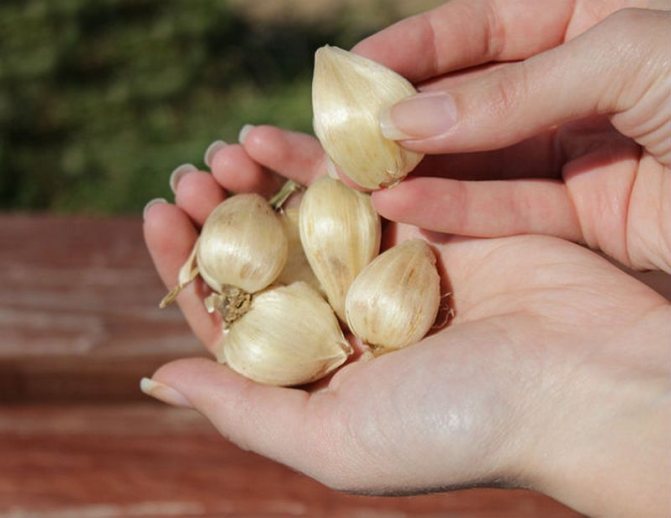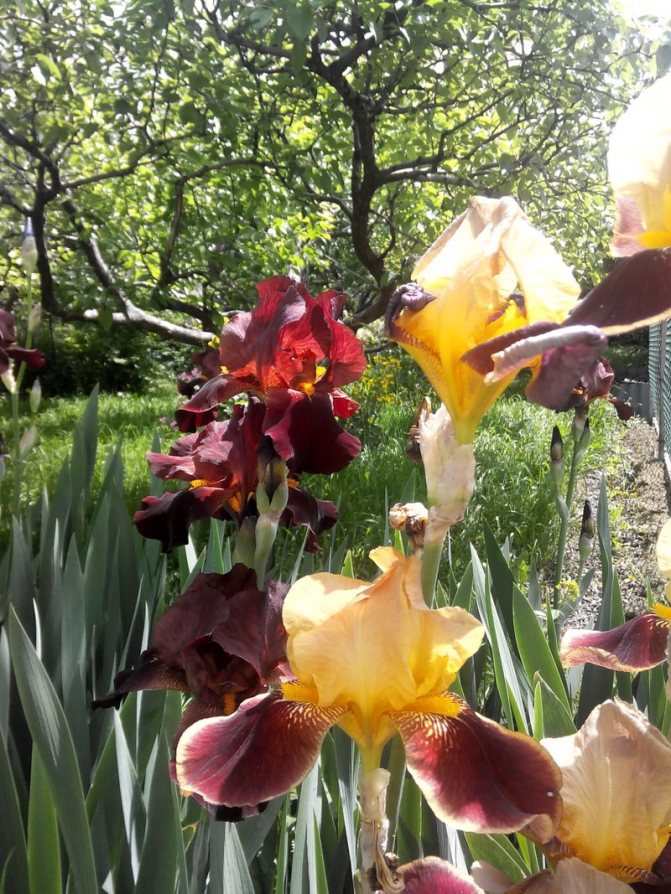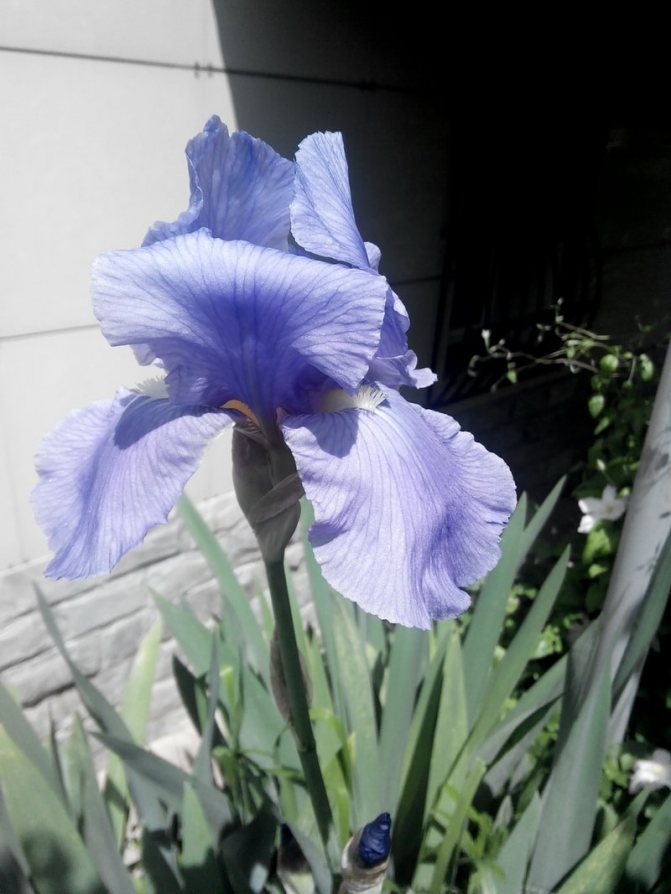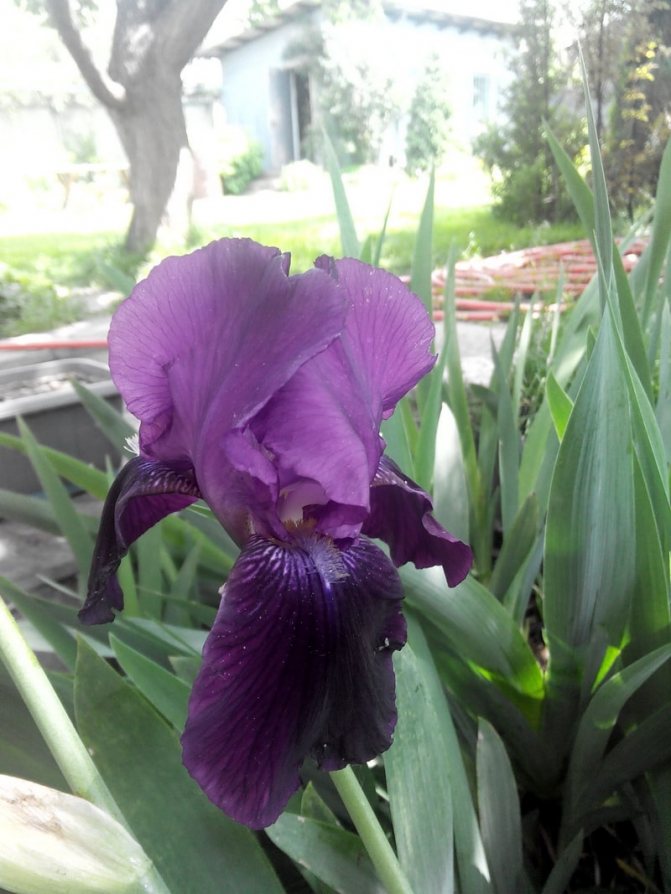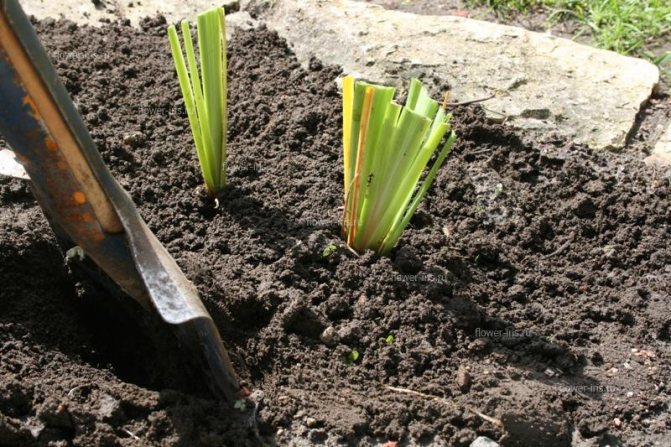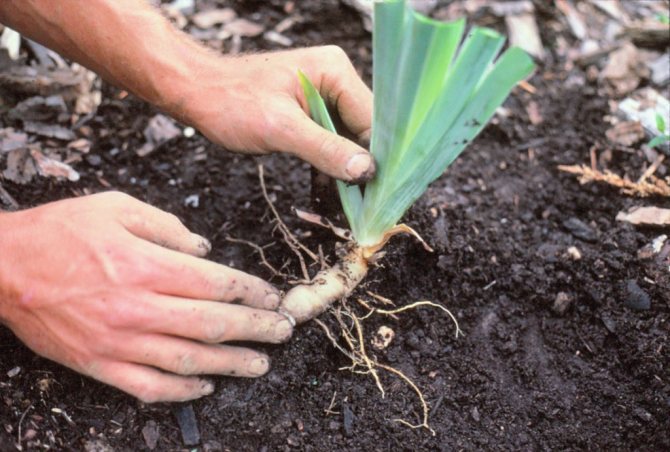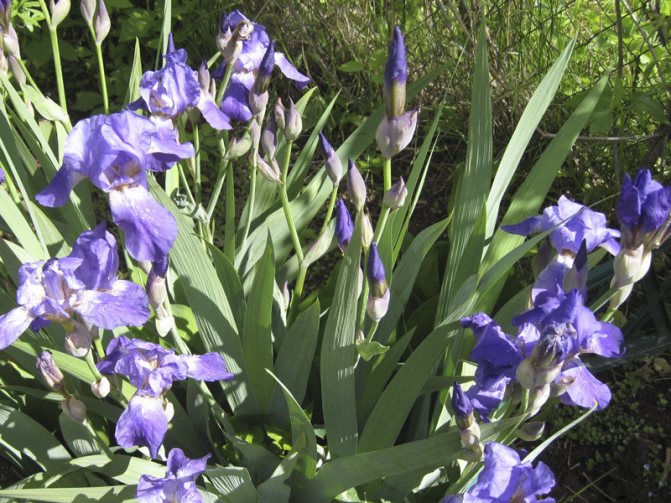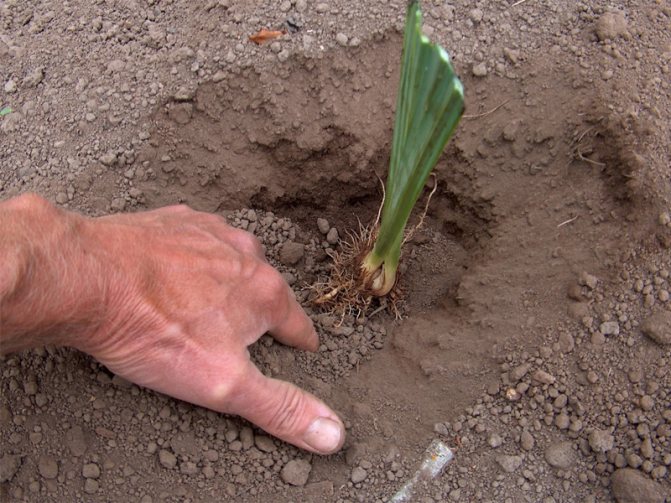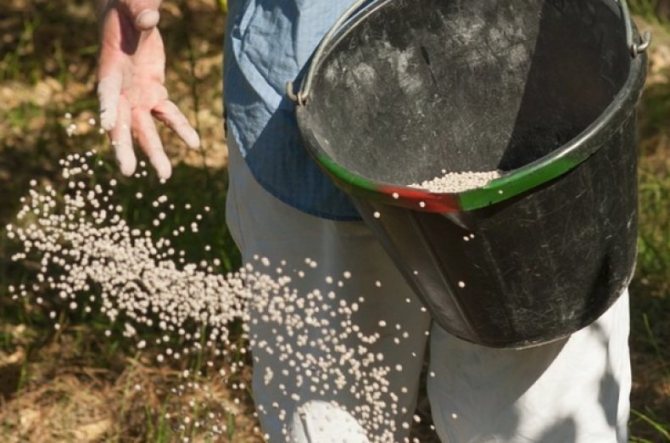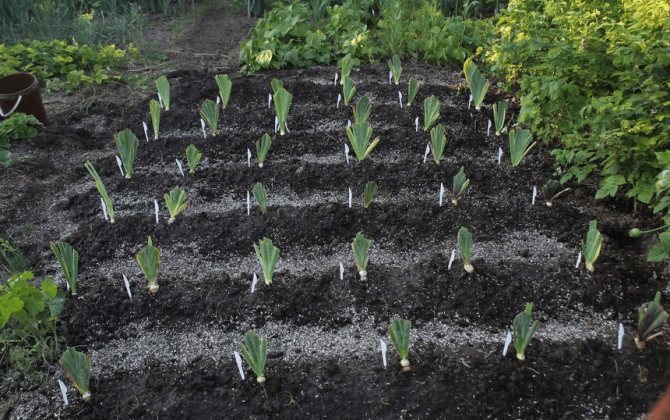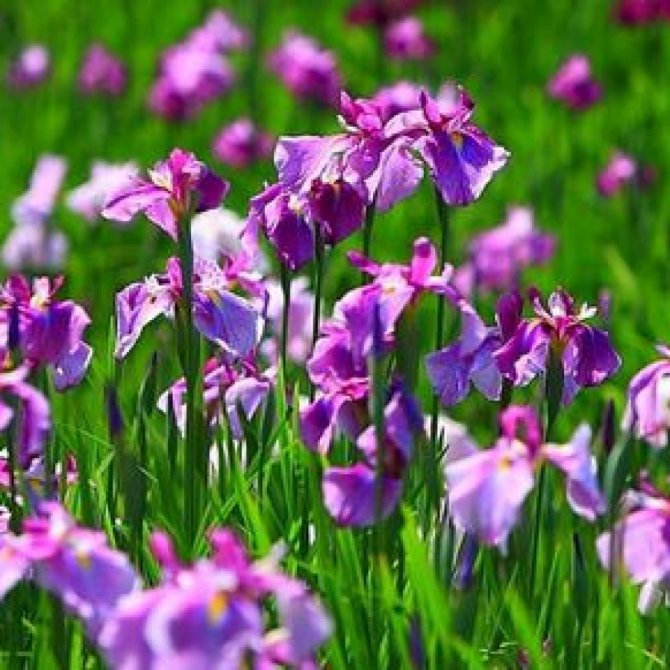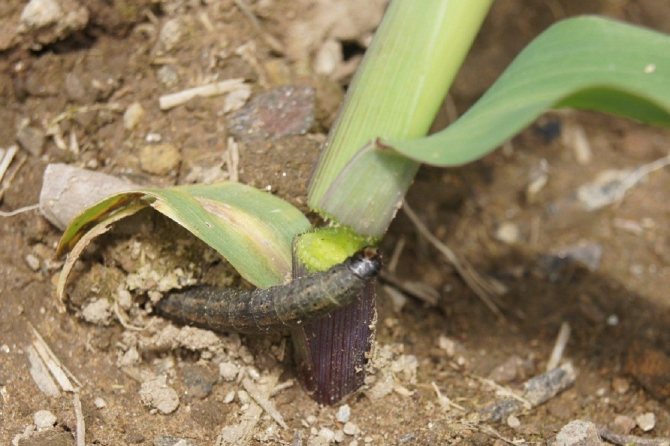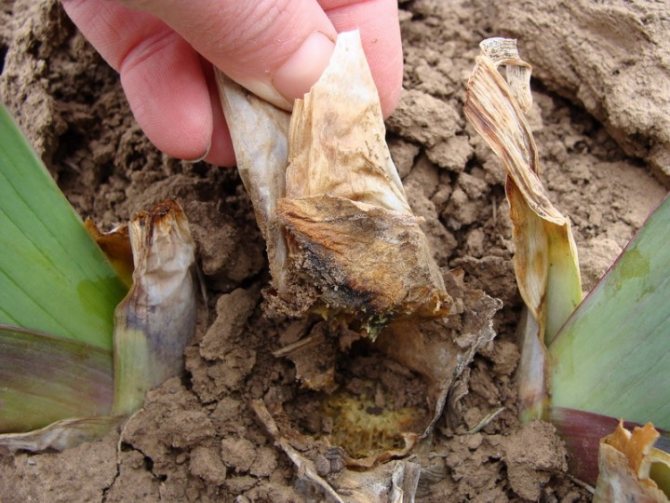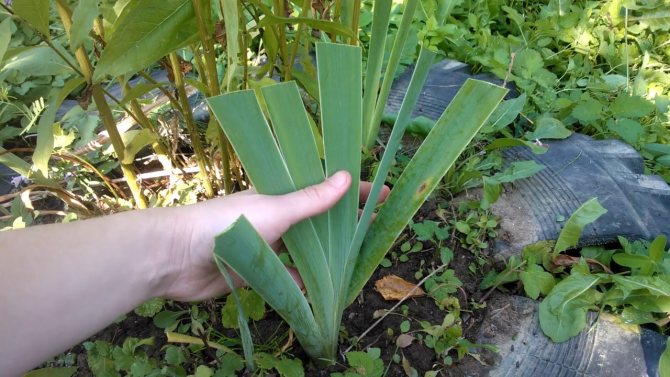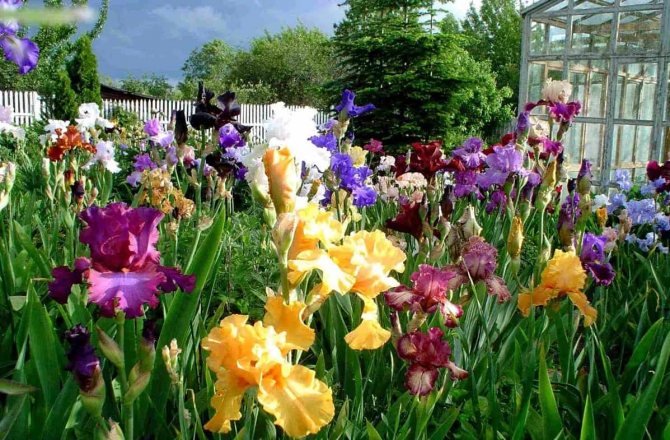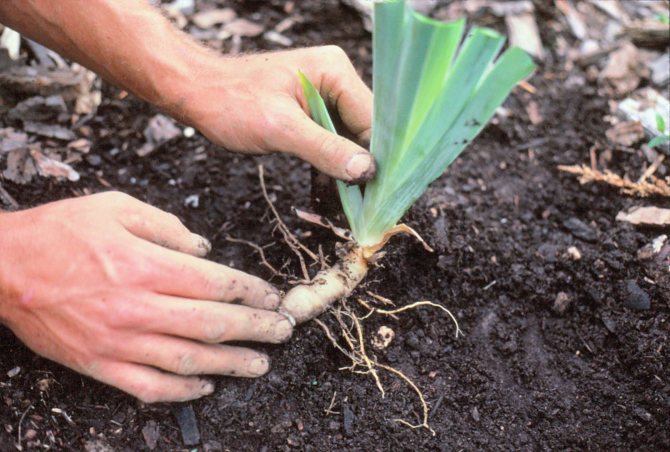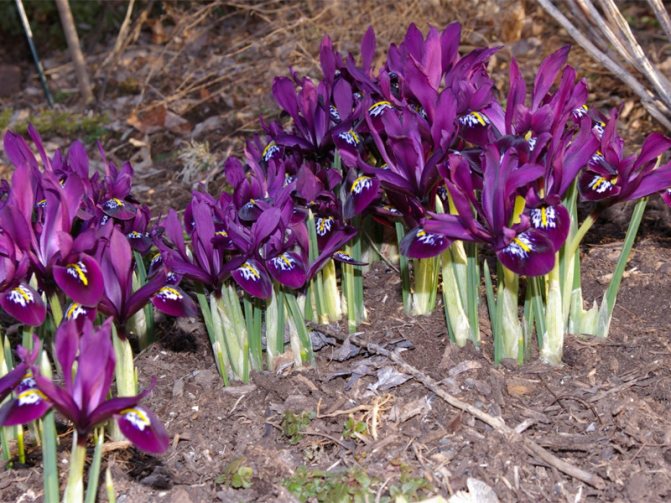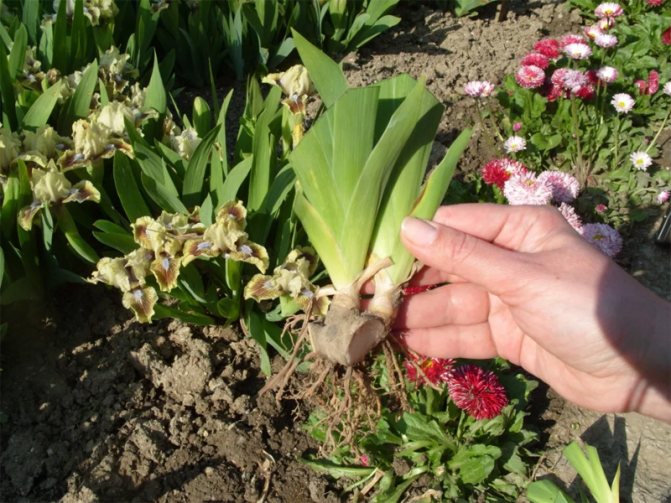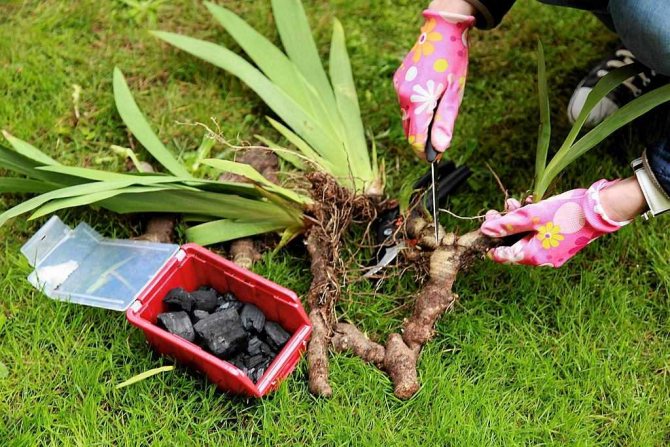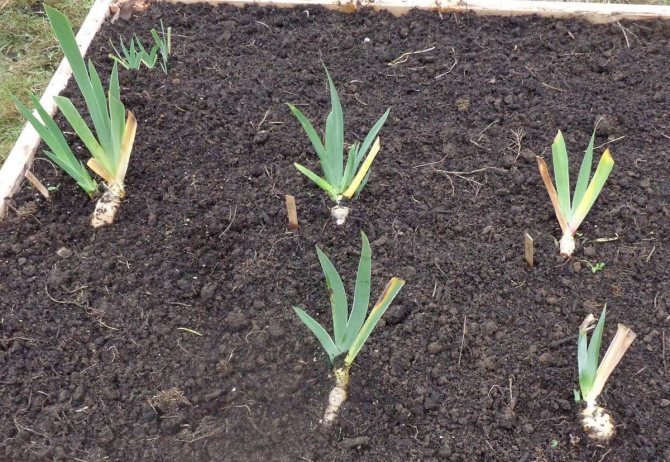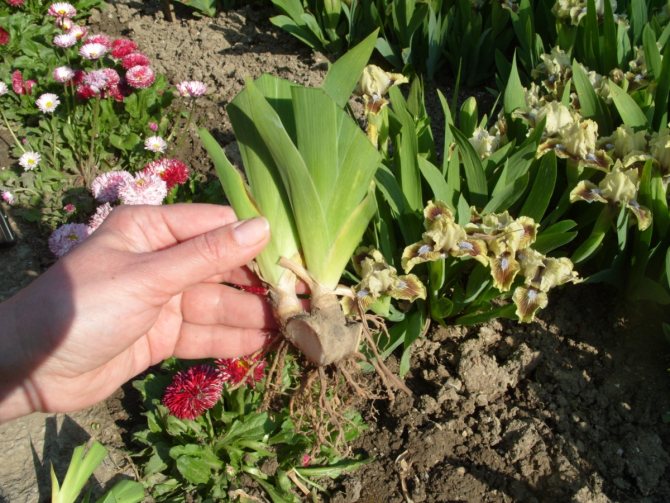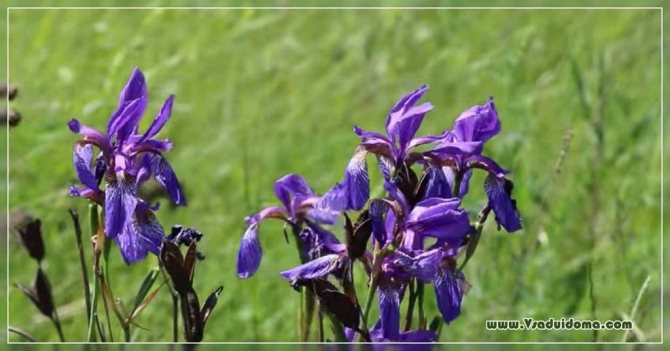
Siberian irises are exquisitely beautiful, few people can remain indifferent to the bizarre lines of flowers, silky petals, as if painted by a mysterious artist. These irises do not freeze in winter, they can bloom magnificently for decades, rarely get sick.
And the hybrid varieties that have appeared are also pleasing with the richness of color. If the petals of natural species are bluish-lilac, then varietal ones can be white, yellow, pink, purple, the color can even overflow from one tone to another.
Today Siberian irises are at their peak of popularity. So it was four thousand years ago, when they decorated the gardens of Egypt, the Babylonian kingdom, Assyria, Crete, Ancient Rome. Medieval
RARE PLANT SEEDS FOR YOUR GARDEN - FREE SHIPPING. PRICES ARE VERY LOW. THERE ARE REVIEWS


Europe also admired them, but the appearance of varietal bearded irises pushed Siberians into the background.
And only the creation of hybrid varieties returned them to their former popularity, they again became desirable in the best gardens and parks in the world.
Siberian irises, despite their name, do not grow in Siberia, but in northern Italy, eastern Switzerland, the Baltic states, Western Belarus, in the high-mountain meadows of the Caucasus and Turkey. We meet in the south of the Arkhangelsk region and in the Komi Republic. And in Siberia, the blood-red iris grows.
It was these two species that became the first parents of hybrid varieties of Siberian iris. Then there were many more crosses, as a result, about 800 hybrid varieties were bred. Considering that breeding work has been carried out since the middle of the last century, the result has been significant.
If the wild-growing iris produces a straight peduncle bearing no more than three flowers, then among the hybrids there are varieties with branched stems that adorn up to seven flowers, which significantly lengthens the flowering period.
A classification of hybrid Siberian irises has already appeared, based on characteristics such as color, shape and size of flowers, height of peduncles and flowering time.
Reference by topic: Siberian irises: growing and care
Siberian irises: eyes, set pieces and fouls
The classic Siberian iris flower consists of three narrow petals, directed upwards (standards), and three wide lower ones (fouls). There is a contrasting spot near their base - an eye. In hybrids, all petals can be wide, and all of them are directed downward or upward. There are varieties with double flowers or corrugated edges of the petals. The size of the flowers varies from 5 cm to 16 cm.
Breeders have done a lot of work with the color of the petals. They can be of the same color, without spots or borders: white, blue, blue, purple, cream, yellow and even pink, crimson and wine red.
The upper and lower petals come in different tones of the same color or different colors. For example, the top petals are white or light blue, while the bottom petals are yellow, blue, pink, or purple. In some varieties, the color of the petals is difficult even to describe - several flowers smoothly flow into each other.
A great advantage of Siberian irises is the strength of the stems, even at a height of 70-120 cm, they do not need support. Medium-sized irises (50-70 cm) are perhaps the most popular among summer residents, and undersized (25-50 cm) and dwarf (15-20 cm) are often planted in parks.
Hybrid Siberian irises are also distinguished by flowering time.There are varieties that bloom in June, but most bloom in July-August. Irises, planted in the shade, bloom later. There are remontant varieties that bloom twice a season: in spring and autumn.
What kind of soil is needed
The soil should be light and fertile. Dig up and fertilize the site with organic (compost or humus) and complex mineral fertilizers. Fresh manure is strictly prohibited.
For planting, small holes are dug and an earthen mound is poured on their bottom. A bush is placed on it, spreading the roots and sprinkling it with earth. Check that the growth point is not buried.
Water well and mulch with humus or compost. Mulching will retain moisture and protect the plant from freezing.
Read interesting articles about transplanting perennial flowers such as,.
Good mood and health to you!
Watch an interesting video.
Irises belong to the Iris (Iris) family. These are beautiful garden flowers that winter outdoors. Irises are propagated in two ways - seed and vegetative. The seed method is most often used for hybridization, and irises bloom in this case only in the 2-3rd year. In horticulture, the vegetative method of growing irises is widely used. This method allows you to get flowering plants the next year after planting. Iris transplants are done every 3-5 years.
Garden irises flowers are very light-loving. They are planted in open sunny areas, protected from the wind, with sufficient groundwater. Loamy soils with a neutral reaction are most suitable for transplanting irises. During preparation, the soil is dug to a depth of 20 cm and a mineral fertilizer is applied, consisting of potassium, phosphorus and nitrogen.
Irises should be transplanted immediately after flowering or at the end of the growing season, in late summer or autumn. At this time, these flowers have a dormant period. With a later transplant, there is a risk that the plants will not have time to take root and will freeze. Most often, irises transplanted in late summer bloom the following spring. The most active flowering occurs in the second or third year.
For the reproduction of irises, a well-developed plant bush is chosen. It is dug out of the soil and gently shaken off the ground. The rhizome is divided in such a way that on each part there is a leaf bundle - a fan and a part of the rhizome of one or two annual links. The leaves of the plant are cut in half, and the roots by one third, and their rotten parts are also cut off.
Then the rhizome is disinfected in a light pink solution of manganese for 15-20 minutes. The cuttings prepared for planting are dried in air, covering the cut with crushed charcoal. For transplanting irises, a hole is prepared so that there is a small mound of earth in its center. A rhizome is placed on it, the root processes are straightened and sprinkled with soil.
When transplanting, irises are not very deep. Distances between plantings are 40-50 cm, and in row spacings - 50 cm. Plants planted at sufficient spacing do not need frequent thinning. For the winter, the rhizomes of irises are mulched with leaves, spruce branches and humus, in order to protect them from freezing.
Care after transplanting irises includes weeding, loosening the soil, feeding and watering.
In the second half of summer, watering these flowers is reduced, since an excess of moisture can lead to decay of the rhizomes. In general, irises are drought-resistant plants, they can do without watering for a long time. But to extend the flowering period, watering is still desirable.
The first top dressing is done in early spring - an easily soluble complete mineral fertilizer is distributed near the root system and embedded in the soil. The second - during the budding period or the beginning of flowering. And the third (without nitrogen fertilization) - in the second phase of the growing season of irises - in August.Thanks to the third top dressing, the resistance of plants to diseases increases and they tolerate frost better.
Garden irises are characterized by gentle flowering - these pretty flowers will decorate any suburban area.
Tatiana Alekseevna, Lipetsk. When is it better to replant irises - in spring or autumn
?
Irises are very unpretentious perennials, and therefore they can grow in the same place for years, but for some reason the bushes of irises bloom less and less often with age, and then cease to form buds altogether. In order for the irises to throw out a large number of peduncles every spring, they need to be transplanted periodically, every five to six years. Florists have not yet come to a consensus on when it is better to divide and rejuvenate the iris bushes - in the fall or late spring, but still professionals believe that this operation should be carried out in September.
Siberian irises varieties


Multicolored iridarium
To give you an idea of the beauty of hybrid irises, we have grouped the most popular varieties by color and present them to your attention.
Siberian irises with white flowers:
Butterfly Fountain, Belissima, Easter C Di Em, Snow Prince, White Pane, Forfold White, Harpswell Shan-tez, Shirley Choice, Aeol (domestic variety).
Siberian irises with yellow flowers:
Butte End Cream, Butte End Suga, Dane Suzie, Dreamin Yellow, Isabelle, Moon Silk, Sunny Spels.
Siberian irises with pink flowers
Valley of Delight, Jax Hele, Dawn Walte, Mary Louise Michie, Roaring Je-Lee, Spacking Rose, Frostyd Cranberry, Hie Wave.
Siberian irises with violet, red-violet and other flowers
Ani Marie Troger, Blackburn Jubilee, Jameykin Welwit, Jeweld Crown, Indie, Lady Vanessa, Owil Faye, Plum Frolik, Sweet Sarrander, Hubbard, Active Duty.
Siberian irises with blue flowers
Vicky Ann, Lady Of Ku-oliti, Lilting Laura, Mae Love, Riverdance, Sally Carlin, Silver Edge, Super Ego, Steps In Blue, Tweed.
Blue-violet, purple Siberian irises:
Liberty Hills, Rafld Welwit, Raflds Round, Reprise, Saltans Ruby, Silver Edge, Super Ego, Toropyzhka (domestic variety), Trim The Welwit, Tylwood, White Conner Swee,
High Standards, Caesare Bryze, Shirley Pope, Eduard Rigel (domestic variety).
Iridescent Siberian irises:
Blackburn Jubilee, Book of Secrets, White Emba.
Bicolor Siberian irises:
Dane Balerine Dane, Shakers Preye, Orientel Cap, Hantis.


Transfer


Reproduction of Siberian iris, as a rule, occurs only vegetatively - young plants are planted after dividing the bush. The best time for this procedure is one month after flowering, when the plant is dormant. The mother bush is subjected to division in the second half of August or early September. However, under favorable weather conditions, this period is extended until October.
First, the leaves are cut by one third, after which the bush is carefully dug out while preserving the earthen coma. With a shovel or a sharp knife, the bush is divided into several parts so that each of them contains at least 3 fans. You can dry the roots of the plant, but just before planting, it is important to soak the planting material well to completely renew the tissues. This procedure is carried out for several hours with weak drying and several days with drier and more damaged roots.
Where to plant Siberian irises
Since frequent transplants of Siberian irises are laborious and undesirable, before planting, you should think about where to settle them. For some reason, it is generally accepted that they love the shadow. In fact, these irises bloom best in areas that are well lit by the sun. Indeed, in nature, they are found along the edges of the forest, in forest glades, floodplain meadows. Therefore, in the garden it is necessary to find a place for them, sufficiently illuminated by the sun, at least half the day.
When planted in a very sunny place, trees and shrubs can become protection from the stinging rays, giving a light shade. In this case, irises should be planted at a distance of 2 m from them, as their roots dry out the soil.
Siberian irises thrive in humid places, but on excessively moist soils, drainage is required to plant them. They can grow in elevated dry places, only then they should be watered more often, especially during flowering. Surprisingly, these irises can even grow on a rocky hill. Low-growing varieties are suitable for such a planting.
Since Siberian irises have strong stems, they can be planted in areas that are open to all winds. Bushes with powerful foliage and strong peduncles successfully resist the wind.
Growing a plant
This flower has some peculiarities when planting and leaving. Transplanting it is difficult and undesirable, so you need to initially determine the area where the flower is to be placed. Iris does not like to be in the shade, it stops blooming. In nature, it grows at the edge of a forest, meadow or meadow. Therefore, in the garden or in the country, a place illuminated by the sun is selected for him. Trees and bushes protect from the active sun. Siberian irises take root on rocky terrain, however, only undersized varieties.
Siberian iris is bred in mixed flower beds, the plant takes root with lilies, catchments, kupavka. A plant in a rich flower garden is placed just below its neighbors, so the place takes on a more decorative look. Planting Siberian iris along a park alley or a summer cottage path creates a unique effect. Flowers planted in two rows look beautiful.
Soil preparation
Until the moment of planting Siberian iris in the ground, they are engaged in soil preparation. Due to the fact that the plant has been growing in one place for many years, the land is equipped with mineral fertilizers. Initially, the soil is dug up, and weeds are removed, the rhizomes of sow thistle, leek, horsetail or bindweed are removed. Land with rich humus is best suited for planting a bush. The plant is planted so that the top of the root system protrudes about 2 centimeters from the soil surface.
Aging in Siberian iris begins at 4 or 10 years, the plant stops blooming. Therefore, flower growers recommend separation and transplantation. The subtlety lies in the fact that the five-year-old iris is planted in the spring, and after reaching the age of six, the iris is transplanted in the fall.
Bedding
Siberian iris is characterized by powerful roots, placed deep enough in the ground, because of this, the plant is planted in a fertile, loose, open ground. Plants for constant, unique flowering need to stay under the sun for at least six hours. The flower grows well near water, prefers moist soil. In no case should plants be placed near trees or bushes with a rich root system, as the iris may stop blooming. When landing, withstand distance over 2 meters... New varieties of irises are planted taking into account the shape of the leaves, 50 centimeters apart.
Purchased roots of Siberian iris are planted like this. Dig holes in the prepared ground. The roots are lowered into the soil by about 7 centimeters, covered with earth, slightly trampled down and enriched with moisture. The soil under the plant is covered with fertilizer or hay. In order for a flower to grow well, it needs moisture. This is achieved by regular mulching of the soil with grass, coniferous needles. This keeps moisture in the soil and protects against weeds. Siberian irises are watered only in the early morning or evening.
Bush care
Siberian iris for many years will be a decoration of a garden or a summer residence, if you devote attention to it. The flower is recommended to be planted in a conspicuous place and looked after so that it does not dry out. After a while, as soon as the shrub grows and the roots become cramped, rejuvenation is carried out, that is, the plant is divided into parts.
Only the sophisticated and fanciful hybrid varieties require special care, in contrast to the simple irises, which are bypassed with minimal attention. Watering plants is carried out rarely, but abundantly, especially at the time of flowering. Bushes need soil mulching. A prepared mixture is introduced under the plant, consisting of:
Gardeners often face a problem when, after planting, the bush grows, and after a while it dies. The reason is root disease, you need to consider their cut. The purchased plant is carefully examined and felt. The iris should be firm and not rotting. In the first year, when the bush grows stronger and takes root, the flower requires careful maintenance.
Reproduction of irises
Hybrid varieties bred by dividing the roots, since the features of the flower are not transmitted through the seeds... Seeds propagate species created by nature. Them self-pollination is characteristic... Seed planting in the fall produces excellent spring seedlings. To divide the bush, the iris is dug out, the adhering earth is removed, the roots are divided. It should be borne in mind that ina mature plant is difficult to divide... The separated part of the rhizome is suitable for planting if there is a one-year-old shoot with foliage and root system. When planting Siberian iris, the main thing is to the roots did not dry... The plant is quickly added dropwise.
Removal of peduncles
The stems of Siberian irises are cut after flowering. Getting rid of the flower stalks and further feeding with phosphorus and potassium contributes to the best bud formation, which guarantees abundant flowering in the coming year. Flowers are not afraid of cold weather, you should take care of this before the onset of winter. Gardeners are in no rush to prune because foliage stores nutrients.
A distinctive feature of a perennial herb is its size. The stem grows up to 110 centimeters, as for the leaves, their length is 80 centimeters. The plant is just the perfect pet for all gardens and parks. Iris has an exquisite shape, unpretentiousness, frost resistance. The bush is not afraid of strong winds.
Neighbors for Siberian irises
In mixed flower beds (mixborders), Siberian irises feel great, since they come from meadow species, where they grow together with daylilies, catchments, acanites, delphiniums and lilies. White and blue varieties of Siberians look especially good against the background of orange swimwear.
In complex flower beds, Siberian irises can be planted in low places, the soil level in which is 10-15 cm below the rest of the surface. Thanks to this trick, the decorativeness of the flower garden will increase, since the height of Siberian irises will visually decrease. In addition, such plantings are very convenient for overflow watering.
When planting only irises in a group, it is necessary to select varieties in such a way that they all bloom at the same time and harmonize in color. Irises of different shades of the same color look beautiful. In this case, the plant with the lightest flowers should be the tallest.
The Siberian iris bush with its green fountains of leaves looks good on the lawn. Against the background of the lawn, a group of 3-5 different varieties can be formed. They can be combined with other perennials such as peonies, daylilies, hosts, oriental poppies.
Advice:
Siberian irises look great against the backdrop of the lawn, but it is important to make sure that the roots of the grass do not get into the circle of irises and do not interfere with their growth.
Planting irises along the paths is also very effective, especially if the paths are curved. Siberians will look even more attractive if they are planted in two rows, placing low varieties in the foreground.
Imagine how beautiful the composition with white or blue Siberian iris will be against the background of carved foliage and bright red flowers of oriental poppy. Such a group is also very effective: dark blue Siberian iris, white-yellow peony Claire de Lune and lupine with chintz color connecting them.
Siberian irises are simply irreplaceable for decorating reservoirs. Bright large flowers reflected in the water will not leave anyone indifferent. Their xiphoid leaves, resembling reeds, look very natural on the shore of a pond. And the high humidity of the air and soil creates the most favorable conditions for the growth and development of these beautiful flowers.
Landscape decoration
- On theback of a mixborder or in the center of an island flower bed good varieties with peduncles above a meter and a classic flower shape with petals bent down. One of the tallest varieties (1.6 m) is a deep blue ‘Hohenflug’ with wide petals. In the foreground, varieties with an open, cupped flower win.
- By the reservoir. Slim graceful leaves blend harmoniously with the surrounding coastal vegetation, and flowers, like moths flying out of the grass, are picturesquely reflected in the water. (Plants are planted on the shore, but not in the water!) Reflecting in the water, irises will enhance their beauty.
Reflecting in the water, irises will enhance their beauty
- By groupson the lawn. If you do not cut the stems after flowering, the spectacular seed pods will add extra interest to the picturesque curtains in the second half of summer and autumn. To make it easier to care for the irises, protect the plantings from the lawn with curb tape and mulch the ground around the bushes.
- In large rockeries group planting is possible, in small ones - use individual specimens as vertical accents or planted miniature varieties ‘Baby Sister’, ‘Summerchase Advent’, ‘Annick’, ‘My Little Sunshine’. Miniature varieties of Siberian irises can rise unexpectedly in a few years. To prevent this from happening, they should share more often.
Lilac and pink varieties are especially effective.
Our market will help you choose varieties of irises, where products from various online stores are collected. See a selection of Siberian irises.
Preparing the soil for planting Siberian irises
Before planting, the soil must be prepared so that the Siberian irises will have enough nutrients for a long time. We remind you that in one place they can grow for 12-15 years.
Preparation should begin with digging the earth and removing weeds, especially rhizomes, such as thistle, wheatgrass, creeping, bindweed, horsetail, which cause a lot of trouble for irises. Despite the fact that the highly developed root system of these flowers forms a very dense sod, even the rhizomes of weeds are taken into it and stitched through it. If there is a lot of weeds, you can clean the area from it with a roundup. However, this should be done a year before planting flowers.
Siberian irises grow best in neutral or slightly acidic soil (pH 5.5-6.5). If there is light loam on the site, and even rich in humus, then the land is the best suited for growing them.
Acidic and heavy soils are improved with lime and sand, and peat is added to alkaline soils to increase acidity. Sandy land is the poorest. Both moisture and nutrients quickly leave it. It is not easy to adapt such a plot for growing Siberian irises, but it is possible by adding a bucket of clay and 2-3 buckets of nutritious compost or peat with humus per 1 m2.
In peaty soils, irises also grow poorly, since such areas are too waterlogged and very acidic, but Siberians can also be grown there by making drainage and adding lime (300-500 g / m2). Clay soil is improved by adding, when digging, a mixture of river sand (10-15 kg / m2) and peat with humus or compost (1-2 buckets / m2).
Reference by topic: Varieties and care of Siberian irises
Preparing the soil for transplanting irises
The place for transplanting irises is chosen sunny, without stagnant groundwater. An area where the water level is close to the surface of the soil is not at all for growing irises. In such places, root tubers are often affected by rot and die.
A suitable area is dug up with the addition of humus and compost.You can also add several glasses of wood ash and superphosphate for digging. Sand is added to heavy soil, which significantly improves its composition.
After loosening the soil, it is watered abundantly, then covered with a film. Planting is carried out in a few days.
Buying irises, behold the root
The rhizomes of Siberian irises do not tolerate drying out. Therefore, when selling, they suffer most often, especially if the sellers have not taken care of them. When buying, pay attention to the packaging of the planting material. The best option is the rhizomes of irises in pots, and it is more reliable if they are grown in domestic nurseries, and not in the greenhouses of Holland.
A good option if the rhizomes are placed in a plastic bag and sprinkled with sphagnum moss, which retains moisture well and is also a natural antiseptic.
Often, the rhizomes are simply sprinkled with peat - this is not the best option, since the roots often turn out to be dry, which is why the irises do not take root well and get sick for a long time.
And of course, do not buy planting material from random people in spontaneous markets. The chances that they will have varieties of hybrid Siberian irises are not only minimal, but we can safely say that they are zero.
The choice of planting material
First of all, it should be noted that the purchase of planting material should be carried out in proven stores or nurseries. The main criteria for a healthy plant are:
- a strong root system without damage and traces of disease;
- the presence of well-developed and young lateral buds;
- rich green leaves.
You should refuse to buy seedlings, the root system of which has soft areas, since such material will not tolerate transportation well and is unlikely to take root on the site after planting. In addition, the yellow color of the leaves indicates that the seedlings have dried out for several days. This means that the planting material was too weak and will start to rot during transportation in a plastic bag.
Planting and replanting irises
Planting of Siberian irises is possible from the second half of August to mid-September and early May. They are also transplanted in the summer, 2-3 weeks after flowering.
If planted later in the spring, there is a great danger of damage to the regrown delicate roots, which will cause the plant to hurt for a long time. A belated autumn planting is also a waste of work. The fact is that for rooting, irises need a month with above-zero air temperatures.
Planting acquired rhizomes of Siberian irises is as follows. In well-dug soil, holes are made so deep that the roots do not bend during planting. The rhizomes are deepened by 5-7 cm, covered with fertile soil, compacted around planted plants and watered.
In spring, during early thaws, irises can be squeezed out to the surface. In this case, they should be buried in a timely manner.
You can also plant in an accelerated way. This is done like this: the blade of the shovel is driven vertically to the full depth, then the shank of the shovel is taken 30-40 degrees to the side and the Siberian iris is planted in the gap formed. After that, they take out a shovel, fall asleep and compact the earth around the roots.
After watering, cover the soil around the plants with peat, compost or cut grass (3-5 cm layer). This mulch will protect the irises from moisture loss in the soil. If the planting was carried out in hot weather, the new plantings should be shaded from the scorching sun. To do this, it is enough to stick branches with leaves into the ground in front of the plants.
If the iris bush growing in the garden needs to be transplanted, they are waiting for the end of flowering. After that, the peduncles are cut off so that the plant does not waste nutrients for seed ripening. After 2-3 weeks, the bush is dug up, the roots, leaves are cut by a third and planted in a previously prepared place, deepening by 5-7 cm.
If the roots of irises purchased by mail dry out during shipment, soak them for several hours in water with a growth stimulant.You can even leave them in the water overnight. When planting several plants on the lawn, the distance between them is 60-70 cm. In mixborders, irises can be planted after 40-50 cm and even after 25 cm. However, in the latter case, every second plant will have to be transplanted after 2-3 years.
Planting irises in the ground
Wells for rhizomes are made with a margin, so that the planting material fits well in them. At the bottom of the hole, drainage is arranged, river sand is poured. The rhizomes are placed in the hole and the roots are straightened. In this case, larger roots are located closer to the surface, and only the filaments of root tubers are added dropwise.
Irises grow very quickly, so leave enough space for the plant to develop and maintain its aesthetic appearance. Experienced gardeners advise planting tubers at a distance of up to 25 cm. After planting, the plot is well watered and mulched with peat, sawdust or just earth.
Watering is required
For the successful cultivation of Siberian irises, high humidity of air and soil is necessary, because under natural conditions they usually grow in wet meadows, where it is damp in spring and cool during their flowering.
However, watering irises often can harm them. The fact is that water has a pH above 7, which means that it is highly likely that it will gradually alkalize the soil. If the color of the leaves turns light green with yellowness, this is a signal that the acidity of the soil is higher than 7.5. In such a situation, nitrogen for the plant becomes difficult to access and the foliage begins to turn yellow. To prevent this, before planting Siberian irises, add sulfur to the soil or water the plants with an aqueous solution of ferrous sulfate (30 g per 10 l of water).
How to keep the soil under the irises cool and moist without flooding them with water every day? This can be easily achieved by mulching the soil with a layer of freshly cut grass, pine or spruce needles. Such a simple agrotechnical technique will not only benefit the plants, but also save them from weeds, you do not have to weed.
It is recommended to water Siberian irises early in the morning (no later than 11 o'clock) or in the evening. At the same time, you should not wet the flower petals so that they do not lose their decorative effect.
Landing space


Since iris is a light-loving plant, it is worth choosing the most open areas. However, when growing Siberian iris in southern latitudes, it is important to remember that excessive exposure to sunlight can be detrimental to delicate flowers. Therefore, in this case, you should choose slightly shaded areas for planting, where active lighting will be only in the morning or in the evening. The cultivation process itself is permissible in dense shade, but under such conditions the plant is unlikely to bloom. A pleasant moment is the opportunity to plant irises in windy areas, since they are not at all afraid of drafts and strong winds. The stems remain stable, the leaves do not break, and the flowers do not break off even after a squally wind.
What feeding is such a bloom
At the beginning of spring, when the snow has not yet melted, and the bushes of Siberian irises are already turning green, it is necessary to carry out the first top dressing with full mineral fertilizer, sprinkling the fertilizer around the bushes. When using kemira-wagon, 60-80 g will be needed for each plant. Fertilizer must be carefully embedded in the soil with a hoe so that its granules do not fall on the growing shoots and do not damage them.
The second feeding is given to Siberians during the formation of buds, so that the flowering is lush and long, and the flowers grow large. Fertilizer can be used both organic (compost, slurry, fermented grass) and full mineral.
For the third time, irises are fed after flowering - after all, they gave so much strength to bloom magnificently.This time, phosphate-potassium fertilizers are used, in which nitrogen is present in minimal quantities (or better, even without it), for example, such as the autumn wagon (10-15 g / m2).
How to prolong the flowering of irises
You can achieve abundant and long-lasting flowering of irises transplanted last year with the help of fertilizers. In early spring, during the budding period, you need to feed the plants several times.
The first feeding is carried out with granular fertilizers, which are poured under each bush. Such fertilizers dissolve well with sediments, delivering all the necessary substances to the roots.
Every gardener seeks to decorate a flower bed, so that irises are pleasing with bright colors, you need to adhere to all the rules of transplantation.
Important!
After transplantation, manure should be discarded as fertilizer.
Beauty protection
Siberian irises, unlike bearded ones, get sick very rarely. Nevertheless, sometimes, especially in rainy years, the base of the leaf tufts is affected by rust. The disease can be stopped by treating the bushes with a 0.4-0.5% solution of copper oxychloride, sold under the name Abiga peak.
Very rarely, the bushes of Siberian irises are also affected by such a disease as scorch: the foliage begins to turn brown, the ends of the leaves dry out and bend. The main means of prevention is the timely division of the bush into several parts, followed by transplantation to another place. For the treatment of irises, they are sprayed with a 0.6-0.8% sulfur suspension solution. In case of severe damage, the plant is dug up and burned, and the earth is spilled with potassium permanganate, bleach or formalin.
Sometimes caterpillars of butterflies: the winter and iris scoop, which overwintered in the ground, in the spring eat away the bases of flower shoots, which leads to their yellowing, and sometimes death. For prevention, in early May, the plant and the soil around it are sprayed with a 10% solution of karbofos. If caterpillars appear, kinmix is used against them (1 ampoule per 8 liters of water), after processing the plant, 2-3 cm of soil is removed, replaced with fresh and spilled with dissolved kinmix, after a week the spraying is repeated.
The yellowing of foliage in Siberian irises is not a disease, but a consequence of a lack of available iron. In this case, you need to spray the leaves and water the soil with iron chelate. Good results are also obtained by mulching with coniferous decay.
It happens that the gladiolus trippe settles in leaf bunches. The color of such leaves becomes brown, and they begin to dry. A tobacco infusion helps to get rid of this pest: 400 g of tobacco dust is poured into 10 liters of water, insisted for two days, filtered and, adding 40 g of laundry soap to the solution, spray the plants. Processed twice at weekly intervals.
Another occupier is the iridescent sawfly. The insect itself is small, but its larvae reach 2 cm in length and are very voracious, often after them only the central veins remain from the leaves. They get rid of them by spraying the plants with insecticides - you can use the kinmix recommended above - however, if only a few plants are affected, it is easier to cut their leaves together with the caterpillars at a height of 10-12 cm and burn them.
Autumn iris transplant technology
1. The land on the flowerbed, intended for planting irises, is dug deep in advance and cleaned of weeds from the roots.
2. A bush that has grown in five years is dug up and very carefully shake off its rhizome from lumps of earth.
3. With a sharp, sterile garden knife, the rhizome is cut into divisions containing one, two, maximum three leaf bundles.
4. Thin roots emanating from the rhizome are slightly shortened, the juicy green leaves in the fans are cut off by two-thirds of the length, withered or diseased ones are removed completely.
5. The cuttings prepared in this way are immersed in a weak, lavender solution of potassium permanganate for an hour, after which the sections are powdered on them with crushed charcoal and the disinfected planting material is laid out under a canopy to dry.
If irises are transplanted in spring, then it is better to do this at the end of April.
6. While the Delayanka are drying in the breeze, holes are dug under them, at least half a meter apart from one another.
Advice. In order for the irises to develop well in a new place subsequently, holes for their planting must be dug wide, with a diameter four times the length of the divisions.
7. The soil extracted from the holes is mixed with coarse-grained river sand and granules of any complex fertilizer of prolonged action. Instead of sand, granite chips or fine gravel can be added to the ground under the irises.
8. At the bottom of each dug hole, a mound of the substrate prepared by the above method is poured. The mound is made so high that its top is flush with the surface of the flower bed.
9. In the center of the hole, on the top of the mound, place a delenk, the roots emanating from it are straightened along the slopes of the hill.
When planting, the tip of the root collar should protrude above the ground
10. The landing hole is covered with a sand-soil mixture.
Attention! To prevent irises from getting sick with root rot, they need to be planted in such a way that the top of the root collar protrudes slightly from the soil.
11. The earth above the rhizome is squeezed with hands and spilled with a solution of "Fitosporin", prepared at the rate of 1 tbsp. a spoonful of liquid concentrate in a bucket of settled water. You don't need to water any more irises. An excess of water in the soil only interferes with their rooting.
12. In November, after the first frost, the planting of irises is covered with a ten-centimeter layer of low-lying peat, on top of which (to retain snow) spruce branches are sometimes laid.
13. In the spring, as soon as all the snow melts in the garden, the spruce branches are removed and peat is raked off the bushes.
In order for irises to bloom profusely, they must be transplanted every 5 years.
14. If the winter was very harsh, and the irises were still slightly frozen, the damaged (become soft and slimy) tissues of the rhizomes are scraped off with a spoon and the wounds formed in their place are smeared with a strong solution of potassium permanganate.
Irises do not need particularly difficult daily maintenance, but in order for these magnificent plants to bloom profusely, they need to be replanted every five years.
Post-flowering care
Faded stems are cut, and as low as possible. Removing flower stalks and phosphorus-potassium fertilizing will help to better plant flower buds, which means lush flowering next year.
For successful wintering in late autumn, leaves are cut off at a height of 12-15 cm.Do not do this too early. Green leaves store nutrients, which means they also contribute to the formation of flower buds. This is why cutting the leaves early can lead to weaker flowering for the next year.
Reference by topic: Types of irises
Siberian irises: planting and care in the open field
Siberian irises do not require special attention, caring for them is simple. You just need to regularly pull out the weeds and periodically gently loosen the soil. Attention should be paid to watering as these plants love moisture.
Young and immature plants need frequent watering. In adult plants, the root system is already well formed, therefore they are less watered. During dry periods, it is better to water the flowers infrequently, but abundantly, so that enough water penetrates deep into the roots.
Fertilizers are applied 2 times a year - in the spring, when the snow melts and when the flower stalks appear. Siberian varieties respond well to potash or ammonium nitrate.
During the flowering period, plants need to be fed with calcium and phosphorus. It is better to add them in liquid form so that the root system does not suffer from burns.
During the dormant period, weeds and dried plant parts can be removed.
Leaves of flowers should be cut off as they wilt and dry out, leaving their length only about 5 cm.
Important! The leaves should not be cut off too early, since the growing buds feed precisely thanks to them. And trimming dried particles, on the contrary, facilitates the germination of young shoots.
Reproduction of Siberian irises
Hybrid Siberian irises are propagated by dividing the rhizomes, since the seeds do not convey the varietal characteristics of the plant. However, natural species can be bred by seed. Moreover, they often pollinate themselves. This is both good and bad. Well, because thanks to self-seeding, Siberian irises are not threatened with extinction: seeds, falling to the ground in autumn, germinate in spring. But in the garden, self-seeding of specific irises, planted together with hybrid varieties, is a disadvantage, since it infests valuable specimens with rootless offspring.
When dividing the bush, the plant is dug up, shaken off from the adhering earth and the rhizome is torn apart. 3-4-year-old irises are easiest to divide, older and older bushes are more difficult to divide. The roots of such plants are so intertwined that they form a large dense turf that cannot be torn apart by hand. Only by using a sharp shovel and knife, it is possible to divide the old bush.
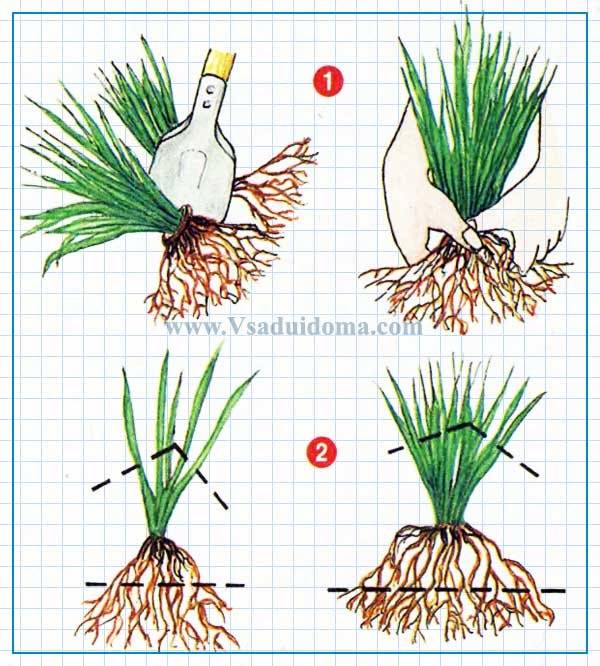

Reproduction of Siberian iris: 1 - dividing the bush; 2 - preparation for planting single-shot and large delenok
You can get planting material without digging up the plants. To do this, they rake off the soil from one side of the bush and separate the leaf bundle with a piece of rhizome with a shovel, sprinkle the cut with crushed charcoal, cover the bush with earth, and the cut is planted in a previously prepared place.
The smallest planting unit should have an annual shoot with a bunch of leaves and roots. However, such delenki bloom only after 2 years, therefore, only very valuable varieties are divided in this way. A typical planting unit consists of 3-4 shoots with roots and leaves. At the delenka, the roots are immediately cut, leaving 5-7 cm, and the leaves are 2/3 of their length. This is done to reduce moisture evaporation.
For Siberian irises, the most important thing is not to dry out the rhizomes. Therefore, they are immediately planted, in extreme cases, they are added dropwise before planting. If the delenki are promised to someone, they are packed in moss, wrapped in plastic wrap and pierced in several places to allow air to reach the roots. During shipment, the roots of Siberians should not dry out, but waterlogging is also undesirable - this can lead to the development of diseases and rot. An important point is the time of division and landing. Although Siberian irises can be transplanted at any time (spring, summer, fall), specific climatic conditions should still be considered. I believe that it is best to plant cuttings in early autumn, leaving one month free of frost for rooting.
Mulching the soil around Siberian plantings is another secret of success. You can mulch with cut grass, pine needles, bark and even straw.
Florist errors when transplanting irises
1. Beginners in floriculture transplant irises in early spring. But this cannot be done. Spring weather is not yet stable, there is a risk of recurrent frosts, heavy precipitation, and this negatively affects the state of unrooted plants.
2. Growing irises in poorly lit areas is not allowed. They love sun and warmth. Without the necessary conditions for flowering, you can not wait.
3. Some growers forget to mulch the soil after transplanting irises, which is unacceptable. If the transplant was carried out at the end of autumn, then mulch is necessary. The rhizomes themselves tolerate frost well, but flower buds may die. With the arrival of spring, the mulching material is removed.
How to create an iridarium with your own hands
The Iridarium is a spectacular iris garden that is easy to maintain and easy to create. It usually consists of 80% irises and 20% other ornamental crops, and cereals are often used. Usually such a garden is small in size and consists of several varieties of irises of different colors, and for collectors this is a great opportunity to present their collection in all its glory.
Where to begin
First you need to decide on the varieties of irises that you want to grow on your site. Remember that varieties with a light color look advantageous against a dark background and vice versa.Try to select varieties so that the flowering of some varieties smoothly turns into the flowering of the next. This will help create a continuous flowering iridarium.
A plot for this garden should be chosen in a sunny place, since irises love warmth and light, it is better if the site is slightly inclined to the south, so the plants will receive more heat, and therefore, the flowering will be bright and abundant.
In natural conditions, irises are often found on rocky terrain, so they will look good on the forefront of stones. A pond will well emphasize the natural beauty of the plant, it is not necessary to depot it in large sizes, a small dug-in bath will be enough.
The site for laying the garden must begin to be prepared in advance, preferably a year in advance. During this time, you will have time to work the soil well, remove weeds.
Landing
Irises are planted in the iridarium in curtains, while leaving a sufficient distance between the plants (at least 50 cm), since the irises grow rapidly. Curtains are arranged asymmetrically, rows of irises are not planted. Irises are transplanted once every 3-4 years, and Siberian irises - once for 8-10 years, otherwise they degenerate and stop blooming.
Advice
Irises prefer fertile soil, so in the spring, before planting, you can add compost and potassium-phosphorus fertilizers. If the soil is acidic on the site, you need to add woody zop.
Irises are planted as follows: sand is poured into the hole, the rhizome of the bearded iris is placed on top, the roots are gently straightened and covered with earth so that the upper part of the rhizome remains above the soil level. Then everything is well watered. The next watering can be done no earlier than three days later. On the contrary, bulbous irises need to be buried into the soil a few centimeters and after planting, sprinkle the soil from above with mulching material.
Care
All irises are very fond of warmth and light - this is the main feature of this culture. There are no difficulties with watering, the main thing is that in the budding phase the plants receive regular and sufficient watering. The main sign that it is time to water is dry soil around the root system.
From top dressing, phosphorus-potassium should be added during growth, but during flowering irises should not be fed. Organic fertilizers are not suitable for fertilizing irises.
During the growing season, you will have to deal with weeds, but remember that the root system of irises is shallow and grows horizontally, so weed carefully so as not to damage the roots. In addition, do not forget to remove faded flowers, otherwise they will become a place of accumulation of insect pests.
<елена прокопенкова,="" агроном-цветовод,="" г.="">
How to transplant irises according to all the rules
The plant must be prepared for transplanting. For this, all subcortexes must be completed at the beginning of August. Before the procedure, all old leaves are cut to a height of about 10 cm.
1. The transplant must be carried out carefully. The bush is dug out with a clod of earth, trying not to damage the roots.
2. An adult bush is divided into several plots of two or three tubers.
3. Prepared tubers need pre-planting treatment. The material is kept in a solution of potassium permanganate for about 15 minutes.
4. After drying, the tubers are ready for planting.
Planting is carried out in pre-prepared soil.
Important!
If transplanted correctly, irises will bloom next spring. Plants grown from seeds bloom only in the third year after planting.
Beardless irises
Persistence, strength, unpretentiousness, growth rate and extraordinary decorativeness - all these advantages are possessed by unbearded irises. Unfortunately, these unassuming beauties are undeservedly deprived of their attention by gardeners and designers, the varietal variety is more modest. But this does not mean that beardless irises do not deserve love and attention.
Beardless irises include: Siberian, Japanese, Californian, Louisiana, marsh, etc.One of the brightest representatives of beardless is Siberian iris.
Siberian Iris (Iris sibihca).
The multi-colored, delicate, floating flowers surrounded by refined linear fanned leaves are striking in their stability.
Another advantage of Siberian irises is the ability to maintain decorative fan-shaped foliage throughout the season. And finally, abundant flowering is an indisputable advantage: 30-40 flowers can open simultaneously on one plant! A real bouquet. Thanks to the achievements of breeders, we can grow such "bouquets" of various colors:
Contrast in Styles - plant about 70 cm high, blooms in late May - June. The flowers are purple-violet, with white-yellow spots closer to the middle.
Kitano-seiza - plant about 70 cm high, blooms in June. The flowers are lavender-pink, semi-double, greenish closer to the middle.
Summer revels - blooms in June. The flower petals are corrugated, the central ones are creamy yellow, and the follicular difference between non-bearded irises and bearded ones is the absence of a bright beard of hairs on the outer lobes of the flower. Their flowers, as a rule, are smaller than those of bearded ones, and (outer petals) are bright yellow. Has a very pleasant honey aroma.


Siberian irises - photo
Ruffled veluet - a plant about 80 cm high. The flowers are velvety, showy, dark purple, with golden strokes in the center.
Butter and Sugar - a plant about 80 cm high, with delicate, large, two-colored flowers: the central petals are white, the fouls are yellow.
Snow queen - snow-white flowers with yellow strokes at the base of the fouls.
Sparkling rose - plant 80 cm high, blooms in June. The flowers are deep pink.
All Siberian irises are very fond of moisture and do not tolerate strong and prolonged drying of the soil and rhizomes, therefore, unlike bearded ones, they need to be slightly deepened when planting. If over time the rhizomes become bare, you need to sprinkle them with earth, restoring the original planting depth.
Siberians, like all beardless irises, prefer nutritious, loamy soil with a slightly acidic or neutral reaction. Grow well in full sun. They can bloom in partial shade, but not so abundantly.
They grow very quickly, they multiply perfectly by dividing the rhizome. Leaves should be pruned 2/3 of the length before planting to balance the aboveground and underground parts of the plant and reduce evaporation.
Siberian irises are very hardy, frost-resistant and, unlike bearded ones, are decorative all season thanks to an unusually beautiful clump of leaves. They are not afraid of the wind either, since their flowers are smaller, and the leaves are thinner.
These beautiful plants will become indispensable for landscaping ponds, they look very impressive in micro-collectors or against the background of trees, and even as tapeworms on the lawn. Do not deprive them of your attention, use them more actively in the design of estates. They are able to delight with beauty and delight!
The most popular varieties of irises with photos
Helen Collingwood
- a kind of bicolor bearded irises. The upper petals are white, while the lower ones are dark, velvety. The iris beard is yellow. Peduncle height reaches 1 meter. Flowering of this variety begins late, the bush grows rapidly in size.
Winners Seckl
- one-color bearded iris. The color of the petals is dark purple with white streaks near the beard. The petals are slightly corrugated, velvety. Peduncle height reaches 80 cm. Flowering begins very early. Gardeners love this variety for its long flowering time.


Siberian iris
- the flower is odorless. The color is very varied. New varieties have been developed with white, lavender and yellow petals.
Snow Queen;
Betts & Suga.
Iris Alberta
- tall, odorless variety. The height of the peduncle is up to 60 cm. From 3 to 7 buds bloom on one bush. The color of the petals is purple, sometimes white.The plant blooms in late May. The rhizomes of this variety tolerate winter well and are disease resistant.
Arkady Raikin
- the variety got the name of the owl in honor of the famous actor. Peduncles of this variety reach 1 meter in height. Up to 7 buds are formed on one bush. The flower is large, more than 13 cm in diameter. The flower lobes are colored in a pleasant pink shade. The inner petals are corrugated, and the outer ones are drooping. This variety has a special persistent aroma.
Gold of Canada
- peduncles of this variety reach 90 cm. Flowers are golden-yellow in color with a pronounced orange beard. The aroma is stable. Iris blooms profusely and for a long time.
Gardeners love irises for their beauty. Plants are often referred to as garden orchids. They are distinguished by their grace and variety of colors.
Irises are very popular among gardeners. There is a huge variety of their colors. And what a splendid aroma they have!
The great advantage of irises is their unpretentiousness. They can grow and bloom on poor soils, in shaded areas, and even with insufficient watering.
Even when flowering ends, their beautiful foliage adorns any flower garden.
But for a good and long flowering irises require care, which, in addition to loosening, weeding and watering, involves replanting them after a certain time.
You will learn from this article. I hope you find it useful.
The soil around them is also compacted. Accordingly, a lack of nutrients is formed, which leads to crushing of flowers and a reduction in their flowering. And some bushes stop blooming altogether. This means that irises need to be transplanted urgently.
Siberian irises - video
Unpretentious garden flowers Siberian iris. Sadviy Mir website
<автор наталья="">
ORDER QUALITY AND CHEAP SEEDS AND OTHER PRODUCTS FOR HOME AND COTTAGE. PRICES ARE BOTTLE. CHECKED! JUST LOOK FOR YOURSELF AND BE AMAZED HOW WE HAVE REVIEWS. GO >>>
Below are other entries on the topic "Cottage and garden - do it yourself"
- Siberian irises: varieties, planting and care: Growing and varieties of Siberian irises At first, ...
- Siberian irises: growing and care: Siberian irises - planting and ...
- Why don't irises bloom? Reasons and elimination: WHAT TO DO IF IRIS IS NOT ...
- Bearded irises - growing care and some varieties: Several recommendations for growing bearded ...
- Irises in questions and answers: Irises planting and leaving: questions ...
- Iris care calendar - from March to August: Iris care - from ...
- Features of growing remontant irises: REPAIR IRISES - GROWING AND ...
Subscribe to updates in our groups and share.
Varieties of flowers
The wild iris is equipped with a straight peduncle with three flowers, and the hybrids produce branched stems with seven flowers. Even the most experienced florists are amazed by the number and variety of varieties, and in fact breeding began only half a century ago. The group of hybrids began their life from a dark red flower and a species iris. At the beginning of the century, the cultivated form of Siberian iris was bred by breeders from a wild plant.
Planting and caring for this plant requires certain skills, it is not the easiest plant to grow. However, with good care, these plants will delight you with incredibly beautiful and abundant flowering.
Hybrid varieties, according to the classification, are distinguished by:
- color;
- form;
- the size of the flowers;
- peduncle height;
- flowering period.
Also, the species differ in the shape and size of the flower and the number of petals. There are such Flower forms are:
- with three petals;
- with six;
- multi-lobed;
- terry;
- over 25 centimeters;
- painted saucers.
Hybrid varieties bloom at different times. Some bushes delight with flowers in early summer, others amaze with colors in July and August. Breeders have bred irises that bloom several times a year.
How to plant irises in a new place
In a new place, it is necessary to timely create conditions for the free growth of each bush.So, the land is already prepared and loosened, fertilizers are present in it.
Plants are placed in holes about 20 centimeters deep and wide, carefully sprinkling with earth to form a small hill.
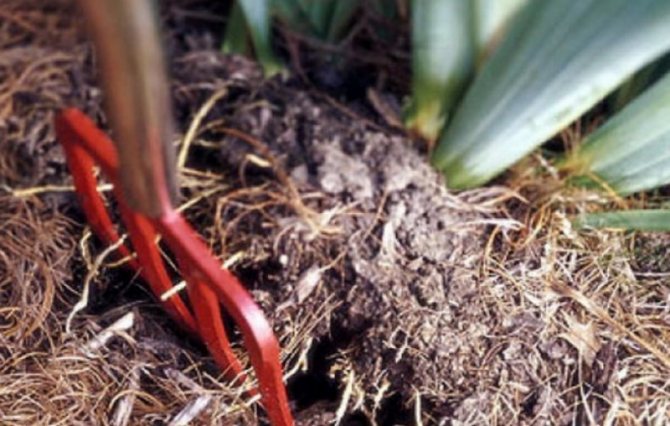

Tips to help you plant irises in the fall:
- Plants should not be placed too deep, or they will start to rot. The top of the root system should be at ground level.
- When planting, the rhizome must be straightened in different directions.
- Choose 3-4 rhizomes for planting.
- All sections must be treated with an antiseptic.
- Choose a dry rather than rainy day for planting.
- It is not necessary to apply fertilizers directly when planting the plant - those that were introduced earlier in the preparation of the soil are enough.
The distance between the holes should be at least 50 centimeters - this will ensure free growth of the bushes in the future.
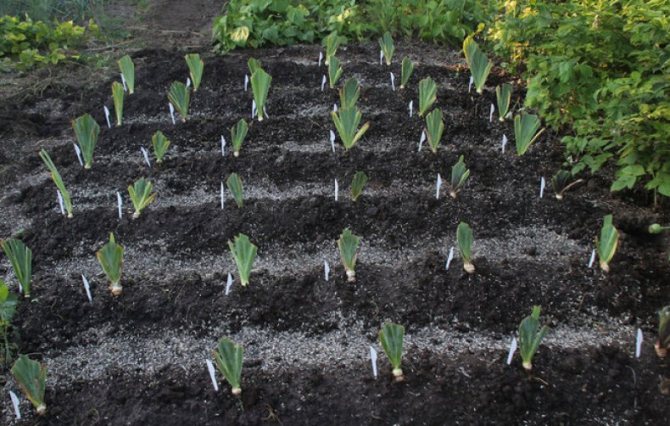

Why and how long do you need to transplant to another place
In order for the bushes to grow and bloom well, they need to create comfortable conditions. To transplant flowers to a new place, you need to choose an area where there is a lot of sun, there must be good ventilation.
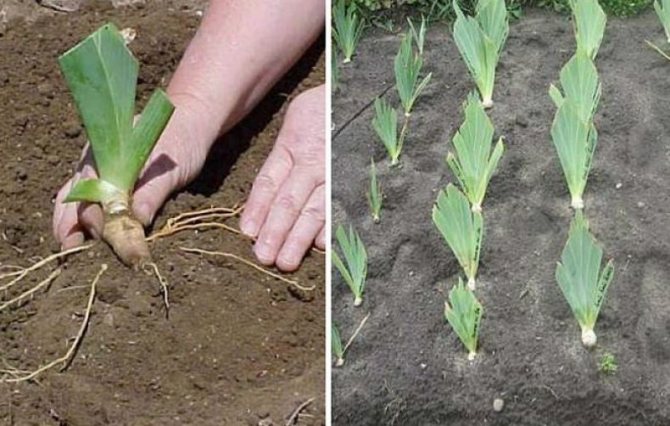

In these conditions, irises feel best and bloom profusely.
A planned transplant should be carried out at least every three or four years. The best time for a flower to settle in a new soil is spring, when the active phase of leaf growth begins. But you can make a transplant in the fall.
When to transplant
The main question when transplanting irises is when is it better to do it? It becomes relevant when, just recently, a neat bush suddenly turns into dense thickets, rhizomes begin to be forced out, and even flowers are small and rare.
In general, irises transplanted at any time are accepted, but experienced summer residents, who have been observing these beautiful flowers for more than one year, believe that spring and early autumn are most suitable for this event. Having bought a piece of iris with a flower, it can also be planted, only the peduncle will have to be removed, and the bunch of leaves should be cut in half. There are rules for transplanting irises, observing which you will create on your land a chic, blooming oasis from year to year:
- Dig out the bush carefully, free the roots from the remnants of the earth. If very dirty, wash with water.
- Remove diseased and dry leaves. You should also cleanse the plant from rotten parts.
- Cut the rhizome with a sharpened blade, with a root and leaves on each shoulder blade.
- Trim the roots and leaves at an angle with scissors. Dip the cuttings in water lightly stained with potassium permanganate.
- Sprinkle the cut with a mixture of sulfur and activated carbon.
- Spread the planting material in the sun, turn it on opposite sides until it dries. This procedure also contributes to the disinfection of the divisions.
- Proceed with transplanting into pre-prepared holes with a distance of 50 cm. After filling them with soil, water well, mulch on top with dry earth.
Varietal variety
Delicate wild-growing irises grow on rocks, in the steppes. For cultivation in greenhouses and cultivation in summer cottages, more than 500 varieties have been bred, which are conventionally divided into categories.
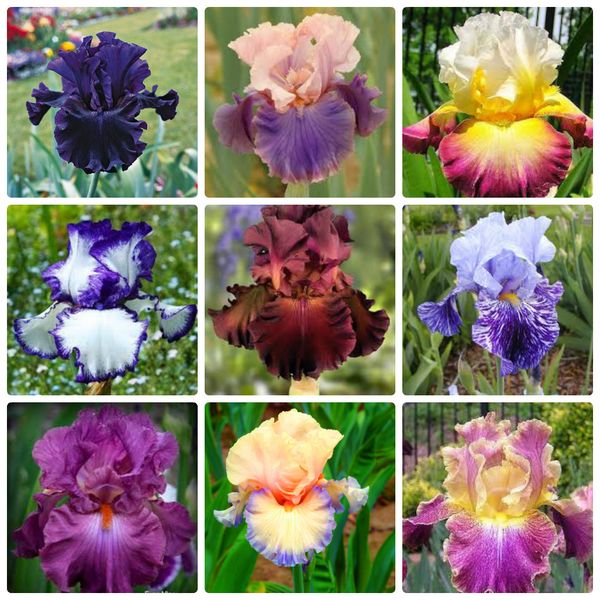

The most popular are:
- bearded irises, which are distinguished by the lower petals, which have small fine hairs. The color of the petals is heterogeneous - the lower petals are usually more intensely colored;
- swampy irises (irises) adorn flower gardens and summer cottages almost everywhere. The peculiarity of the flower is long leaves (about 1.5-2.0 m). Since iris easily tolerates partial shade, it is planted under fences or near trees, the crown of which is not very dense. This is a completely picky variety that requires a minimum of care;
- dwarf irises exquisitely decorate compact flower beds. Peduncles grow no higher than 40 cm. Therefore, the ideal options are to plant plants along paths or on hills;
- bulbous irises (Dutch) already in early spring delight summer residents with their delicate flowering and enchanting aroma. The first flowers bloom as soon as the snow melts;
- Siberian irises retain their beautiful decorative appearance throughout the season. thanks to the rich green foliage. The variety is planted every 7-9 years. Plant rhizomes are deepened more deeply than other varieties. The tubers do not need to be dried after disinfection. After dividing and until planting, the planting material is kept in moist sand.
Hybrid varieties grow the fastest. In one place, irises can be grown for about 5 years. It should be borne in mind that if the plants are not planted in time, the flowers will become smaller, and the bushes will gradually degenerate. This is due to the fact that the tubers of irises will multiply, bulge out of the ground, a hole will form in the center of the bush.
Diseases of Siberian irises
With improper care, the death of the flower is possible. Iris is not picky to care for, but with excessive watering or planting in the wrong place, it is exposed to the following diseases:
- Bacteriosis
- rot of the root system. The development of the disease is facilitated by an excess of calcium in mineral fertilizers or abundant watering. Symptoms of bacteriosis: drying of the tips of the leaves, an unpleasant odor from the stem, slowing down the growth of the specimen. It is impossible to save such a plant, but it is possible to prevent its infection by pretreating the cut. - Fusarium
- a fungal disease, manifested by yellowing and drying of iris leaves. The affected specimen is dug out of the soil and destroyed. - Gray rot
... The symptom of the disease is the formation of a light bloom on the buds, leaves and stems. The lesions are especially clearly visible on specimens with dark flowers. These include Siberian iris Bundle of Joy, Concord Crash. You can save a sick bush. If damaged parts are removed in a timely manner and treated with fungicides.
Preparing for winter
Irises are plants that are not afraid of winter frosts, so you should not resort to any serious insulation measures.
But in order for the shrub to successfully overwinter, it should still be given attention and several procedures should be carried out:
- The leaves are trimmed so that the height of the plant as a result of cropping is about five centimeters.
- Roots that are above the ground must be sprinkled, otherwise they may freeze.
- The prepared shrub is covered with dry leaves, which are fixed, for example, with boards.
The soil
It is important to have more than just information about when to plant iris. You need to know what kind of soil this plant loves. Proper soil preparation will allow you to grow healthy and strong flowers that will decorate the garden for a long time. The soil must be nutritious. It must be loosened regularly. Before planting, you need to apply fertilizer to the soil. If this is not possible, then this must be done as soon as possible after the flowers have been placed in the soil.
Irises should be planted on well-drained, dry, well-heated soil. When to plant iris? This is done, as a rule, in early autumn, in September, or in the middle of spring. At this time, the soil meets all the requirements for the flowers to grow beautiful and healthy.
Optimal timing
The question of when to transplant - in spring or autumn - is always relevant.
The best time to transport Irises to a new location is early autumn. This is due to the fact that after flowering, the plant has enough strength and time for further rooting.
In addition, the activity of insects is reduced, to which flowers are especially susceptible in the first days after the procedure.
The ideal option is to wait for the moment when the buds get stronger, and the rhizome will greatly increase the mass.
The end of the active growth phase falls on the second half of August, transplanting is allowed until mid-October.
At a later time, it is not recommended to carry out work, their consequence will be the death of the plant or low decorative characteristics and poor development.
Lunar calendar
In 2019, the most favorable days for transplanting Irises in September fall on 4-6 and 27-29, in October - on 2-8, 25-31.
By region
For complete rooting in a new area, the bush needs at least 1.5 months from the moment the seed is embedded in the ground.
Therefore, it is very important to take into account the climatic conditions relative to the regions:
- The Leningrad Region is characterized by an early setting of low temperatures, and therefore the optimal time for planting a flower is at the end of July or August.
- In the Moscow region, the procedure should be carried out in the fall by mid-September.
- In Siberia, you need to cope with gardening work throughout September, because the air temperature is rapidly decreasing from the second half of October.
- In Belarus, the transplant is carried out starting from mid-October.
- In Ukraine, the most favorable period is determined relative to the location of the site. This is due to the very noticeable differences in climatic conditions between the southern and northern parts.
Choosing a place on the site
When choosing a site, it should be remembered that these flowers are light-loving, therefore it is recommended to select a site with good access to light and wind, preferably without shadows and excess moisture.
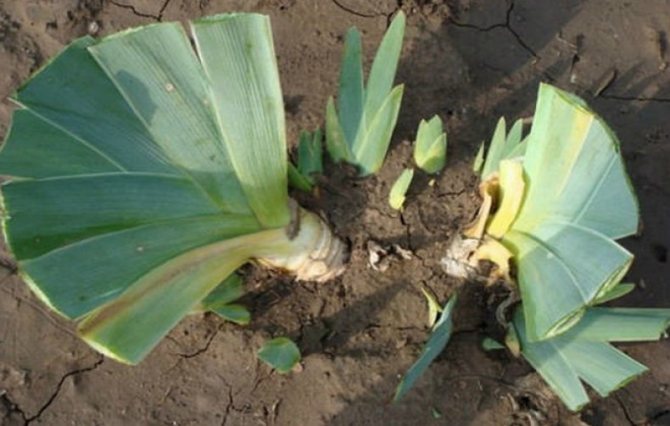

Too much water in the soil can lead to root rot or mold and other diseases. Therefore, you need to monitor the level of groundwater in the new location.
It is not recommended to plant a bush in heavy and acidic soil. The best option would be to place the young plant in a neutral loamy soil.
Lighting should be bright enough, and bushes also like ventilated places, but not with strong winds. It should be remembered that the planting site must be prepared in advance by digging up the soil.
Iris transplant in the Moscow region and Siberia
Iris take root so quickly that the month is not so important for their planting. The main thing is to pay attention to the climatic features, and also to choose drained soils with the presence of clay, ignoring sandstones.
In the Moscow region, in the Urals, in Siberia, they do not particularly ask themselves the question of when irises can be transplanted from one place to another. For flower growers in these regions, each warm month is good for working on a flower bed.
Spring planting
It is better to prepare a new bed in the fall, digging up and adding compost, humus, a little lime and bone meal. The shrub can also be prepared from September. To do this, it is enough to cut off the new shoulder blades from the old rhizome and leave in place until spring.
Additional Information. If in the southern regions they start planting already at the end of March, then for central Russia it is worth focusing on the second half of April - early May. Those who have been dealing with irises for a long time have already noticed that the May plantings bloom earlier than the April ones.
As soon as the soil warms up to the desired temperature, young bushes are dug in and transferred to a new place of residence. In case of recurrent frosts, it is better to immediately sprinkle fresh plantings with sawdust for a while, so that due to temperature changes, the roots are not damaged.
Important! When planting in spring, it is recommended to plant several divisions in one hole, forming its own mound for each layer. At the same time, a hole with a diameter of 0.4 m is deepened to 15 cm. Gardeners who transplanted flowers in the spring of 2019 admired their killer whales this year.
Summer landings
Those who decide to start breeding irises in the summer should start the procedure in the second half of July or August, when the flowers on the bush will wither. The rules for preparing the site, planting material and the work algorithm do not differ from those described above, but there are small nuances:
- the new site intended for transplantation is watered abundantly a few days before the main work;
- the soil is loosened to a depth of 20 cm and nitrophosphate is added (80-90 g / m2);
- the roots are buried in small pits just below the ground level;
- the direction of the fan of leaves is south, this will allow the plant to develop symmetrically;
- filling the hole, part of the scapula is left peeking out of the ground;
- water the plantings with warm water so as not to injure the plants by the temperature difference.
On a note! The transplanted irises will not bloom this year, but they have enough time to root thoroughly and prepare for the winter period.
Landing in the fall
In cool regions, autumn planting is also practiced, the most suitable time for this is the first half of September. Transplanted iris needs at least 2 weeks to take root before frost, which occurs in Central Russia since October.
If irises are transplanted in the fall, the soil is dug up, but not fertilized - a complex top dressing is applied under the rhizomes in early spring. Sprinkling roots in the hole, a small "back" is left to look out on the surface.
Important! If the rhizomes are completely buried, without giving the opportunity to "sunbathe" in the sun, the plant will quickly rot. This is an important point, no matter what season is chosen for transplanting.
When several shoulder blades are planted in one hole, it is better to place them around the perimeter of the circle. So it will be easier for young plants to winter. New plantings in October are sprinkled with leaves, and if winter is foreseen with little snow, then from November they are additionally covered with spruce branches.
If the cold weather comes earlier than expected, the bush can be divided into layers and planted in a greenhouse with light nutritious soil until spring. Or rooted in flower pots with a substrate and planted in a permanent place when the spring frosts pass.
Having decided on the time of relocation of flowers, having studied the information on how to transplant irises correctly, even a novice gardener can easily cope with this work and very soon will begin to enjoy the beauty of his multi-colored flower bed.
One of the rules for caring for flowers is their constant and timely transplantation. You need to know when it is better to move a flower to a new place, how to choose the right place, what is needed for work and how to carry out the transplanting process. Most gardeners, both beginners and experienced, are interested in the question of when and how to replant the frequently occurring irises. We will tell you about their transplantation to a new place in the autumn, their subsequent care and the necessary rules that should be adhered to.
How to transplant
In order for a new flower bed of irises to bloom with all colors and paints, you need to adhere to several conditions when transplanting.
Preparatory measures:
- Initially, for irises, you should choose a place that will meet all its requirements:
- The flower bed should be spacious.
- It should be in a well-lit place.
- The soil should not be too wet.
- Soil preparation:
- The land must be well fertilized.
- Do not overmoisten the soil by limiting watering.
- Planting trenches should be of medium depth so that the bush does not sink too deep into the ground, otherwise it will rot.
Plant preparation for transplant
- Extracting a plant from the ground:
- The bush is released from the soil gently without damage.
- The root system is neatly divided into separate pieces of ten centimeters each.
- The formed sections should contain about five healthy leaves.
- The root system needs to be corrected.
- Shrub preparation for planting:
- Cleaning the roots from rotten and damaged areas.
- Pruning the leaves of the plant so that the height does not exceed five to six centimeters.
- Disinfection of the root system.
Planting iris in the soil:
- The location of the sprouts in the trench:
- Correct placement of roots in the trench relative to adjacent bushes.
- Root laying.
- Post-landing actions:
- Abundant watering
- Compaction of the soil.
Preparing the soil
Since irises love the sun, but do not tolerate excess moisture, it is worth taking care of the formation of a flower bed.
This can be done without special technologies or ideas - it is enough to properly organize the soil:
- The earth under the garden bed is dug deep enough - the depth is on the bayonet of the shovel.
- When the earth is dug up, all extraneous roots of pest plants must be removed from it.
- The preparation of trenches is carried out long before the direct disembarkation, almost three months before the process.
- First you need to set the level. It is desirable that the land in the flowerbed, where the iris will grow, should rise by ten centimeters. So that the shape of the flower bed does not collapse during watering and processing, the edges of the flower bed are strengthened.
- Form a slight slope towards the south, as irises adore sunlight.
- For planting irises, the soil is usually lightened by adding sand and peat to it, and then mixed with the main soil.
- Since irises do not like excessive moisture, it is important to think over a drainage system so that the plant does not die in case of heavy rainfall.
Naturally, you cannot do without fertilizing and fertilizing the earth before planting irises.
Fertilization should be made using mineral and organic substances:
- The land for planting under irises is not fertilized with manure, as it can harm the root of the plant, namely, burn it.
- In the form of fertilizer, a mixture of soil and compost can enter.
- When fertilizing, one should not overdo it with fertilizer - ten kilograms of fertilizer should fall on one plant bush.
- In the process of growth, constant feeding of irises is necessary, otherwise the flowering will be very poor.
We divide the rhizomes
Transplanting and planting irises involves the preliminary preparation of the plant, namely the shrub. Of course, the overgrown bush must be pre-processed, namely divided.
This is done in order to update the root system. This must be done very carefully, since a divided plant may not take root during transplantation.
Consider these rules:
- The division of the rhizome is carried out only after the period of flowering of the iris is over.
Approximately this can be done after two weeks of the end of the flowering period. - For division, bushes are used no older than three years,
which have a fan-shaped leaf structure and a well-developed root system. - Separation of shrubs can be done with your hands or with a knife,
but at the same time, before each division, the roots are disinfected by soaking them in a light solution of manganese for several hours. - After this exposure, the roots of the shrubs are dried for two weeks,
and only after that they are planted in the soil.
Landing in the ground
When all the preliminary treatments of the iris bushes are completed, you can start planting.
But here, too, there are many tricks and tricks:
- In the garden or flower bed, depressions are formed, in the center of which there remains a small hill on which the bush will be placed.
- The depth of the recess is about three to four centimeters. The distance between the pits should be about sixty centimeters.
- The roots are spread over the entire groove so that they do not overlap.
- After distributing the root system and installing the shrub, you can fill the depression with earth. After that, the seedlings are tamped and watered, if necessary.
Where are irises grown?
Speaking about the timing of planting irises, it is necessary to tell where you can grow these flowers. Some people plant this plant in gardens and orchards. For this, a small place is allocated, which is most often located along a fence or path. This arrangement of flowers allows you to decorate the garden.
When can I plant irises? Gardeners do this in early autumn, in September.If the bulbs are purchased in the spring season, the irises are planted in pots. Before these plants became widespread, some varieties of them were grown at home as a houseplant.
There is another option where to plant irises. These flowers look great on lawns and flower beds. They can be placed either singly or in groups. They quietly coexist with other plants. The main thing is that the requirements for growing irises and other flowers are similar.
Features of the growing season of irises
Annual transplanting of irises in the fall is not required, but once every 3-4 years it is necessary to plant the plant in order to rid it of old roots. New roots will grow quickly. Without a transplant, they cease to bloom violently already in the 5th year. This is especially important for varietal flowers.
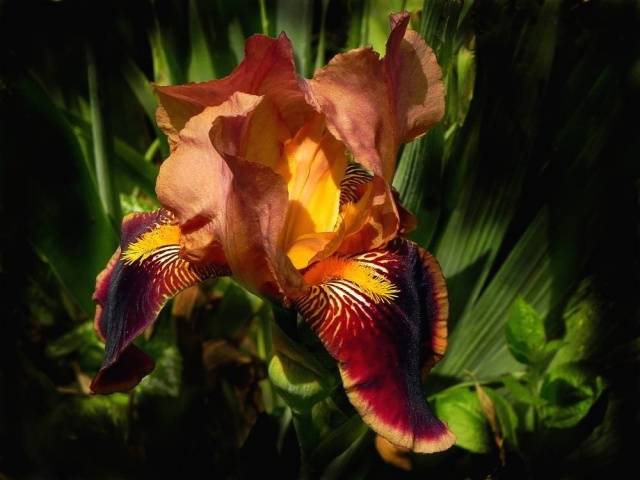

Irises bloom from the second half of May to the end of June, depending on the variety and regional affiliation. But with the end of flowering, their growing season does not end.
The growing season of irises throughout the year is divided into several stages:
- With the onset of spring, as soon as the snow melts, they rapidly build up the aerial part of the plant. Judge for yourself, in just a month and a half, from the first shoots, they turn into lush green bushes and the first buds appear on them. It is for this reason that many flower growers advise against transplanting irises in the spring. Indeed, for rapid growth during this period, they need a well-rooted underground part of the plant. Planting irises in the fall is more preferable.
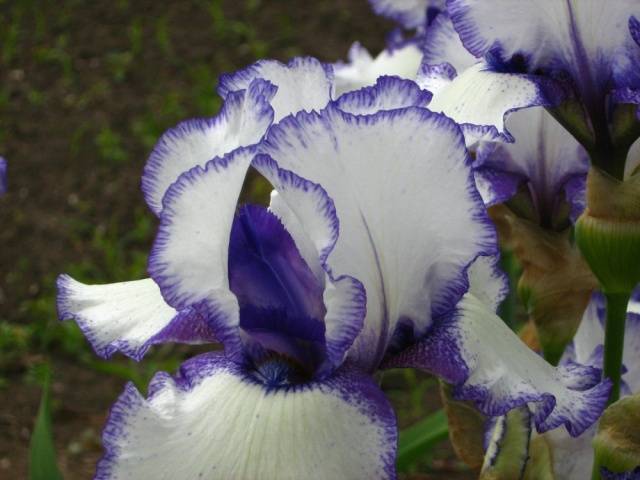

- At the end of the flowering phase in early July, active development of the root system begins. During this period, new links are formed, on which young buds will appear by autumn. They will bloom next spring. Therefore, if you decide to transplant irises, it is important to catch the moment when the new links have grown, but there are no buds yet. Summer iris transplantation is dangerous in that the newly formed delicate buds can be easily damaged. Despite numerous tips, it is still not worth making a transplant until mid-August.
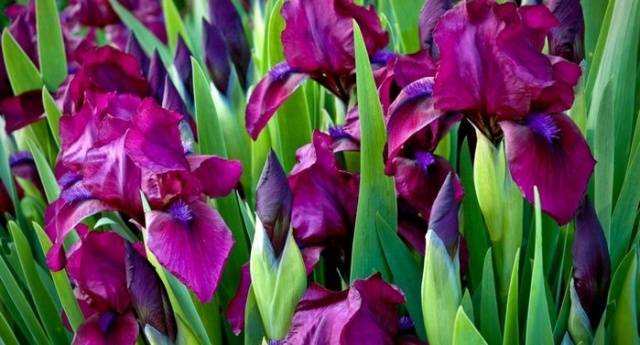

- By the second half of August, the root system of irises ends the phase of active development. Young buds formed on the links have grown stronger and are perfectly visible to the naked eye. This factor is of no small importance when dividing a large bush into several small ones. From now until mid-October is the ideal time to transplant and plant irises in the fall.
Children of the rainbow
Iris (Iris) - one of the favorites of flower growers, is a representative of the Kasatikov family, therefore it is often called affectionately Iris. Another (popular) name for this flower is also very characteristic - cockerel. After all, its lower, lowered colorful petals are very reminiscent of rooster's "earrings".
The very name of the flower came from ancient times and is dedicated to the goddess of the rainbow Iris. And for good reason! After all, irises have a huge number of shades and color combinations.
We love iris by gardeners not only for its exquisite and noble beauty. The flowering time of these plants (late spring - early summer) very successfully helps to fill the pause when the spring primroses have already retired, and the summer ones are still gathering strength.
And most importantly, looking at the delicate petals gleaming with some kind of magical glow, it is hard to believe that iris is very undemanding to care for.
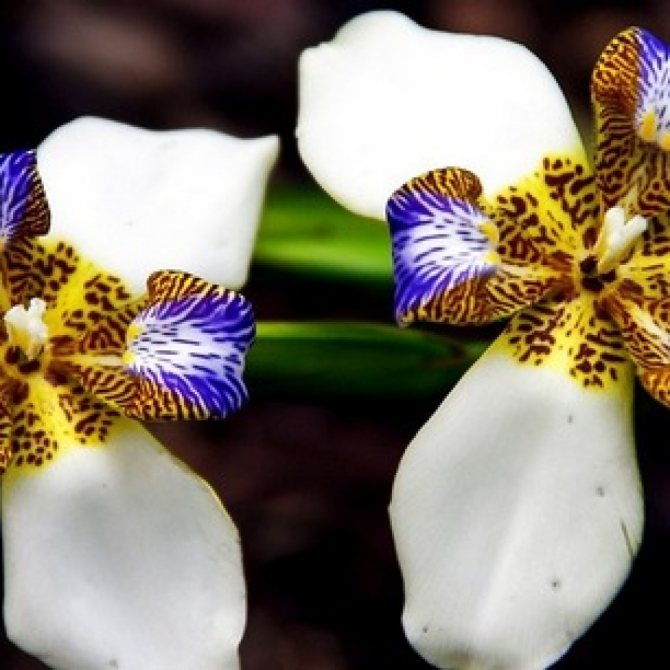

But the minimum care for the iris, of course, is necessary. And when it's autumn in the yard, it's time to figure out what kind of preparation of irises for winter is needed.
Pests of Siberian irises
The plant has pests that feed on its juice and molding. They cause iris disease or death. The list of insect pests includes:
- Slugs
... The worms are activated at night and feed on the stems and leaves of the plant. To protect the culture in the ground, ash or treat the flower with tincture of bitter pepper. - Aphid
... The insect drinks the sap of the plant and causes it to dry out.Siberian iris Cambridge and other varieties are sprayed with soda (0.5%) or karbofos (0.3%) to protect against pests. - Thrips
... To combat the pest, summer residents use karbofos diluted in water in a ratio of 75 g per 10 liters. - Nematodes
... Insects survive even during the cold season. To combat the problem, the garden tools are processed with formalin and the weeding of the summer cottage is carried out.
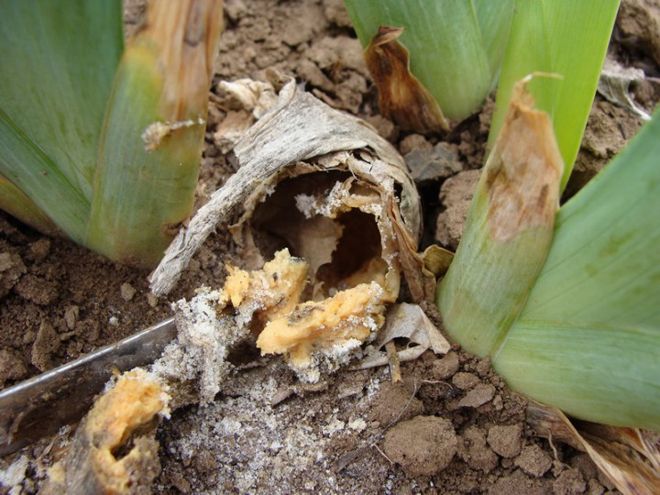

Bulbous irises
To know how and when bulbous irises are planted, you need to familiarize yourself with the features of this plant. Flowers of this type are divided into three groups: iridodictium, juno and xyphium.
Iridodictium is a short plant, up to 15 centimeters in size. It has a small bulb and filament-like roots. The flowers are single, they consist of six petals growing in two rows. During the flowering period, narrow leaves appear, which reach a length of 20 centimeters. The color of iris iridodictium can be anything from white to purple. Flowering begins in spring and lasts for two to three weeks. This type of iris is best adapted to the temperature conditions in Russia. This plant is perennial. It can grow in one place for five years.
Juno is another type of irises. This plant is considered the rarest of its kind. It blooms in spring, most often in April or May. Its bulb is fleshy, the roots are thick. However, they are susceptible to mechanical damage: they can be easily torn off. The leaves of the plant are narrow and long. Their length reaches 20 centimeters. A sinus of two flowers grows on the peduncle. Their color is most often represented by a white-yellow or lilac shade. This type of iris should be grown in warm, bright, sunny locations such as Central Asia or the Caucasus.
When to plant xyphium irises? This plant blooms during the warmer months, from early June to early July. In September, the period of their rest begins, at the same time the roots die off. Xyphyum is the largest type of bulbous irises. These plants have a fleshy bulb and a strong root system. Their leaves are long and narrow. Flowers are painted in various shades. These can be pastel colors, for example, pale pink, and bright ones, such as yellow and blue speckled.
When to plant irises in autumn
The best time to move is after flowering or growing. If irises are transplanted during flowering or too late afterwards, they will most likely not tolerate transplanting.
It is worth choosing the time in early autumn - it is best to get down to business in September, while it is still warm. But in late autumn, after mid-October, a transplant is not recommended - the iris may not take root and wither.
Transplanting in the fall also has several advantages - at this time, the rhizomes are not forced out, which means that this does not reduce the duration and abundance of flowering. Also during this period the bush grows well, it can be planted after that or left to bloom and get a large number of flowers.
Plant information
These flowers can be seen everywhere: from Europe to the Far East. The common name of the species comes from the name of the goddess of the rainbow - Iris. This is no coincidence - among the varieties of iris there is such an abundance of colors that, by combining them on one plantation, it is easy to count all the shades of the spectrum.
Despite the name of the group, Siberians are bred mainly in Holland and Germany. The name reflects the ability of irises to winter in the open field, even in a harsh winter.
The main purpose of the killer whales is to decorate the landscape. Flowers look good in large rockeries, on alpine slides, near ponds and yard buildings. It is enough to plant one root, and in a couple of years there will be a gorgeous bush in this place.
Iris Siberian Iris is also a medicinal plant, in which the rhizome is the most valuable. This part of the flower contains essential oils, resins, starch, tannins, flavonoids, mucus, and sugars. This composition determines the widespread use of iris in traditional medicine:
- healers call the raw material "tooth root", which already determines the main application;
- decoctions and infusions are used for diseases of the upper respiratory tract, as an expectorant;
- in case of problems with the gastrointestinal tract, the rhizome of iris gives an enveloping effect;
- homeopaths recommend using drugs for sciatica and migraines;
- since ancient times, wounds have been sprinkled with powder for quick healing.
On a note! This variety of irises was not ignored by the official industry. The crushed rhizome is used in the preparation of tooth powders and dusts, medicinal plasters and cosmetics. The remedy has also found its place in perfumery - the essential oil ketone iron has a violet smell.
Features for different varieties
Bearded


Choose healthy plants for planting
Some of the most interesting outwardly Irises. The contour line of their petals is covered with yellow bristles, which serve to attract insects for pollination.
Propagated mainly by the method of dividing the bush, for which part of the overgrown green mass, together with the rhizome, is dug up with a shovel.
After that, the segments are disassembled either by pulling them out by hand, or with the help of garden tools.
It should be borne in mind that each such division must have at least one one-year-old link and leaves.
The more the latter, the better - the likelihood of the formation of a flower bud for the next season increases.
Additionally, it is necessary to trim the leaves by about ⅔ of the entire length and remove, if any, flower stalks. Also, the cut is inspected for the presence of soft areas, which are cut out with a sharp knife. Subsequently, the seed is treated in an aqueous solution of potassium permanganate and dried for a couple of days in partial shade.
Siberian
The fundamental factors in transplanting Siberian Irises are their requirements regarding the growing area.
- They feel comfortable in light shade near trees and bushes.
- They love water, however, special waterlogging of the soil can lead to death. They are characterized by a powerful underground part, reaching a length of half a meter and serving as a pump for obtaining liquid.
- They do not need to be tied up due to the elastic trunk, due to which it is permissible to place the plant in areas unprotected from the wind.
In one place flowers can exist for up to 10 years. A transplant is required subject to thickening. It is also carried out by dividing the bush, each segment of which should be placed at a sufficient distance from each other.
In addition, rotted compost is introduced into the hole, and the substrate itself is improved - it is made looser and the level of acidity normalized.
With a small number of divisions, their temporary germination in separate pots is allowed, thus the plant is protected from freezing. If necessary, the seedlings are brought into the room.
Bulbous
In addition to Irises, the underground part of which is represented by the rhizome, other varieties of this plant are also cultivated - xyphyums, junoes, iridodictiums. The roots of all three are in the form of bulbs.
Without a transplant, the bushes feel comfortable for 3-4 years with the condition of not too active growth in breadth.
In terms of the process technology, the chronology is identical to the standard one: the mother bush is divided by means of a garden fork and the segments are moved to the selected area.
Follow-up care
It is rarely necessary to water the plants after transplantation, since a cold period is approaching, and an excess of moisture will prevent the bush from taking root. Fertilizing should also not be done.
After transplanting, dry leaves may appear, but this is quite normal, since the flower is just getting used to a new place: fresh new leaves will soon grow.
Preparation for wintering plants at this stage ends. Since they are winter-hardy, there is no need to cover and insulate them, the necessary pruning has already been done. There is no need for special care after such a transplant.
Irises are very beautiful flowers, easy to care for and maintain. The process of transplanting them is quite simple. The main thing is the right choice of place and its preparation.
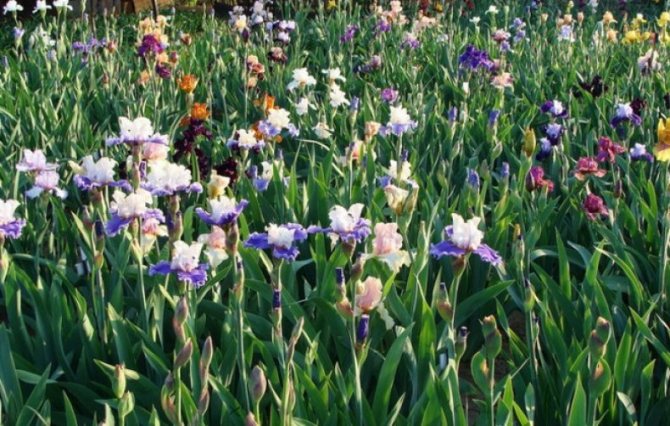

If you carry out this process as expected, then the bush will grow well even in autumn and have enough strength to calmly overwinter and very soon please you with beautiful flowers.
Transplant methods
Irises are transplanted by digging up the plant completely or by separating a part of the rhizome from it, called a layering, a spatula, a fan, a cut. Having dug up the plant, the rhizome is divided into separate links, which have their own rosette with roots. Without completely removing the mother bush from the ground, the scapula is separated with a sharp knife, and then dug out with a shovel. The cut off place is disinfected with brilliant green or ash. Thus, two tasks are performed: transplanting and rejuvenating the old bush.
Regardless of the method and time of transplanting irises, parts of the rhizome are separated from the bush, at the age of 1 year, having a diameter of 10 to 20 mm and a length of 20 mm, together with leaves. Having separated the link, the roots are immediately shortened, leaving only 30-50 mm, then a fan of leaves in the form of a cone is cut by 1/3. Before planting in a new place, the cuttings may lie down for several days.
When there are links without leaves and roots from the dug out old bush, do not rush to throw them away, if they are healthy, plant them in the garden. The next season will sprout.
If it is necessary to transplant the bush completely, then it is carefully dug out using a pitchfork, trying not to damage the rhizome. Then they inspect, shorten the leaves, remove the damaged areas, disinfect in a 0.2% solution of potassium permanganate, dry slightly and only then transfer them to a new place.
There are varieties of irises that grow poorly - their rhizome grows actively, this takes all the energy, so the buds do not wake up. Even in this case, it is possible to obtain material for transplantation, using the following trick
:
- Across the rhizome, between the apical bundle of leaves and dormant buds, we cut out a narrow wedge.
- Sprinkle the cut with charcoal or activated charcoal. For the next growing season, the buds will wake up and give a few scapulae ready to be separated and transplanted.
Preparatory work
There are certain steps to follow when transplanting to a new location. After its selection, the soil is prepared and fertilized, in addition, the plant itself is prepared.


Soil preparation
The place for the flower should be dug up in advance, at least a week or two in advance. Ideally, this preparation is carried out even several weeks before the planned movement of the irises. They dig a hole about twenty centimeters deep, that is, into the bayonet of a shovel.
If necessary, sand and peat are added to the soil. If the soil is too acidic, be sure to add at least a handful of lime.
It is also important to feed the land: for this, mineral fertilizers are suitable, to which the bushes respond well. If you fed iris with one type of fertilizer, then use them again.
Plant preparation
If the bushes are already old and very large, it is better to dig them out using a pitchfork, planting the roots on them a little. This case cannot be done without damage, since the roots of the plant are very fragile.
Therefore, if the volume is quite large, you will have to separate them and transplant only some part. After the main part of the roots that will be transplanted has been selected, they can be rinsed with water.
This will allow you to view the state of the system and determine whether these particular divisions should be used. Sick, dry and damaged parts are removed.
For transplanting in the fall, you need to choose potash and phosphorus fertilizers - nitrogen fertilizers are not suitable at this time.
Organics are very poorly tolerated by plants, it is better to add ash to the hole, about a handful or two, and after that plant the iris in a new place.
Why do the buds of Siberian iris dry up?
Another problem that summer residents may face is the blackening of the bush's inflorescences. They do not have time to bloom and immediately fade. Drying of buds occurs for two reasons: infection with root rot or damage to the shrub by insects. The grower needs to break the flower and examine it for pests. All damaged inflorescences are cut and destroyed. A sick specimen is treated with insecticides to avoid problems the next year.
If there are no insect larvae in the inflorescences, this means that the flower is infected with root rot. A sick specimen is sprayed with any fungicide. Siberian iris Miss Apple and other varieties can be saved with Glyokladin. Several tablets of the drug are buried under each affected bush. When controlling root rot, it is also important to reduce the frequency and amount of watering.
Landing
Planting and caring for Siberian iris is identical to the agricultural technology of other groups. But there are still some features, they should be considered in detail.
Site preparation
Despite their winter hardiness, irises prefer to grow in sunny flower beds, but they can be planted in partial shade. More attention should be paid to the soil, because in one place the flowers will grow for several years. Therefore, the soil on the site must be sufficiently nutritious.
Slightly acidic or neutral soils are most attractive for culture, therefore loams are most suitable. If you come across a heavy acidic earth, it is "diluted" with sand and lime. Alkaline soil is supplemented with peat.
Note! It is better not to plant irises in clean sand - a very poor soil composition that is not able to retain moisture.
Having cleared the land of weeds, it is dug up and well loosened. If a vacant lot is chosen for planting, then it is better to ennoble it under a flower bed in advance, in the fall, in order to use it next year.
a brief description of
Before answering the question of when to plant iris, you need to talk about this plant. These flowers belong to plants from a family called Iris, or Iris. They are rhizome. These flowers can be found everywhere. In total, about seven hundred of their varieties are known, each of which is attractive in its own way.
According to legend, Hippocrates gave the name to this plant. Irises are named after Iris, the goddess of the rainbow. Probably, the scientist relied on the appearance of the flowers, choosing names for them. Florence got its name from irises, because the fields nearby were planted with them. From the very beginning of our era, these flowers have become widely sought after. Most often they were used as decorative elements, but with the development of the perfume industry, they became widespread as raw materials for essences.
Gardeners reviews
Holguin Khutor, Pechory
I always thought that irises are easy! I bought an iris with a flower on the market. Handsome! It bloomed well, and then stopped blooming altogether. I read the topic. I am thinking if I should transplant it? Moreover, there is already a whole bush.
Tasha32
I have a very difficult relationship with irises. On the one hand, I love (how not to love such beauty?), And on the other hand, it is very annoying when the foliage begins to lose its decorative effect and turn flower beds into a trash can. I process them periodically (along with tomatoes and / or phlox), but there is no sense. Has anyone dealt with such problems?
How to plant irises?
The question of when to plant irises outdoors is very popular. Another fairly common question: how to plant flowers? This is done in the spring or fall. For this, small pits are dug, the depth of which is no more than ten centimeters.If onion-type irises are planted, then the distance between the holes should be from 10 to 15 centimeters. The distance can be shortened or lengthened. It depends on the size of the bulbs: the larger they are, the greater the distance between them should be.
When to plant irises outdoors? Flowerbeds are most often created in spring. Moreover, they must rise above the ground by at least 15 centimeters. It is necessary to first apply fertilizers to the soil - both mineral and organic. After that, the soil is loosened and, with the help of a pitchfork, a flowerbed inclined to the south is erected. If the soil has been fertilized with manure, you should postpone the planting of irises until the next season.
These flowers are also very popular because there is no need to transplant them annually. For five to ten years, they can grow in the same place. If the bushes grow strongly, then they are seated.
Pest control
When is the best time to plant irises? Such a procedure is carried out in the spring. When the period of active growth of flowers begins, irises become most susceptible to the appearance of various pests. Most often, this plant is attacked by a bear, naked slugs, a root mite and a purple caterpillar. To prevent iris from suffering from all these organisms, it is necessary to take preventive measures.
First, the plant should be sprayed regularly. This is done every week. Secondly, it is necessary to control the condition of the flower, carefully monitor the condition of the stem and roots. The part of the plant that is underground is the most difficult for humans to access. At the same time, it is very vulnerable to various diseases. Often, the root system of irises suffers from the appearance of rot on it. If it was not possible to prevent its occurrence, the rot is removed, and the flowers are treated with a special solution of potassium permanganate. After that, the roots are thoroughly dried in the sun, and the soil is thrown away. If you take action in time, you can save the irises. Subsequently, they will bloom as beautifully as healthy plants.
Growth stages
Irises grow rapidly; in one season, several stages of their development pass. Let's consider them using the example of flowers that were planted in open ground in spring. It is during this time of the year that the initial stages of growth occur. When to plant irises outdoors in spring? This is done in April or May, since the soil has time to warm up and the plant is not threatened with hypothermia.
First, the growth of the aerial part occurs. In just 40 or 50 days, the plant has a bush and flower stalks on which the buds are located. In order for irises to grow beautiful and healthy, they need a strong root system. That is why, during spring planting, the underground part develops first, and after that, towards the end of this season, flowering begins. How to plant irises in spring? This must be done carefully so as not to damage the fragile bulb of the plant or its fragile root system.
When flowering ends in July, new links grow on the roots. Subsequently, kidneys appear on them. In the summer, a plant is transplanted. It is carried out at a time when there are no buds on the regrown root. They are very fragile and easily damaged during transplantation.
In autumn, from the end of August to October, you can plant irises in the open ground. At this time of the year, the root system of the plant is quite developed, the buds are already strong and lignified, they can be easily distinguished. Irises have time to take root before the onset of the first frost. They tolerate winter well and start growing in early spring. In one season, a bush grows from a small seedling of irises. He is ready to breed next year.
Characteristic
Siberian Iris is a perennial herbaceous plant. Many varieties of this species are characterized by a complete lack of aroma, despite the fact that the root contains a lot of esters.A description of the plant can be presented in the table.
| Plant parts | Features of the |
| Stem | Strong, branched at the top. On average, it reaches a height of 1-1.2 m |
| Leaves | The aerial part is large, xiphoid. On the stem - numerous, linear, in the upper part - reduced. All have a rich gray-green hue |
| Flowers | Large, located on peduncles in the axils of the upper sheets. The perianth is actinomorphic, six-partite. The color depends on the hybrid variety, but liliaceae and violet-blue are more common. |
| Fetus | Box 3-chained, which contains many flat small seeds |
| Rhizome | Fleshy, thick, branched-creeping, giving numerous thin roots located close to the surface of the earth. Usually the color of the rhizome is white |
What does Siberian iris look like?
Iris blooms in May and early July and pleases with its beauty throughout the summer. It is recommended to keep the plant in one place for no more than 5 years, then plant it in new areas.
Temperature conditions. Cold protection
Many gardeners who have not yet grown these flowers are wondering: when to plant irises? In autumn, you can plant the bulbs in open ground. Then the plants will have to spend the winter. This means that it is necessary to take care of creating optimal temperature conditions. For this, a shelter is built from peat (it can be replaced with branches of spruce branches) and dry leaves. The fact is that the roots grow horizontally. They can appear above the ground. If this happens during the cold season, the plant will die. With the onset of spring, the shelter is stripped. This is done to warm up the roots of the plant. If in winter the underground part of the iris is frozen, the wound is cleaned to a hard tissue, and the damaged area is treated with a solution of potassium permanganate or ordinary brilliant green. How to understand that the roots are frozen? They take on the appearance of porridge.
What are irises
Irises are rhizome and bulbous. TO bulbous
Irises include iridodictium, juno and xyphyum, and the garden forms created on the basis of xyphyum are known as Dutch, Spanish and English hybrids. Bulbs of iridodictiums, English and some Dutch irises can hibernate in the ground, especially if you organize them a reliable shelter, but Spanish hybrids and junons do not differ in winter hardiness.
Concerning rhizome irises
, of which about 250 species are known, then in the garden classification (not to be confused with botanical) these plants are divided into 10 groups. The most popular among them are bearded, Siberian, Louisiana and Japanese irises, as well as spuria irises.
Requirements for the growing conditions of bulbous and rhizome irises, including the timing of their transplantation, differ.
Decorative qualities
As mentioned earlier, irises are flowers that have become widespread in the design and perfume industry. What qualities do plants have? Why are they attractive to people from all over the world?
Firstly, irises have a unique color palette: you can find flowers of almost any color. Some plants are pastel colored, while others are very bright. There are some representatives of the Iris family, whose petals are white and even black. Spring irises, which are compared to snowdrops due to the timing of their appearance, are considered the most beautiful.
Secondly, they do not require particularly careful maintenance. Of course, it is necessary to take measures to prevent various diseases, fight pests and loosen the soil. However, irises have excellent vitality, they easily tolerate frosts, they have good immunity.
Irises have been used in flower beds and lawns for quite some time. For the original shape of the inflorescence, they are even called ground orchids. Irises are also so loved by gardeners for their huge variety of shades: from lavender, cream, white to copper, bronze, chocolate, etc.With proper care, which, by the way, is quite simple (timely watering, loosening and protection from weeds), irises can grow in one place and bloom regularly for 5, or even all 7 years. However, there comes a time when replanting irises becomes absolutely necessary in order to preserve this type of plant in your backyard.
We understand some of the features of the life cycle of irises
To understand how and when it is better to transplant irises, you must first learn some of the subtleties regarding their growth, namely, periods of activity and periods of rest.
Planting the growth of the current year and flowering
Like many rhizome perennial plants, the ground part of irises dies off every year, and dormant replacement buds remain in the leaf axils during the winter. In early summer, with the emergence of young shoots from these buds, the laying of flower buds begins. If you want to get a flower bed with blooming irises already this season, then you need to plant only young plants with about 8 fully developed leaves. They are strong enough to release a peduncle and delight you with flowering this year.


Bookmark inflorescences next year
The end of summer - the beginning of autumn is a very important stage in the development of this plant species. At this time, inflorescences are laid for the next flowering period and young roots are formed. How to look after and will it be better given this aspect? Firstly, in August-September, irises need especially careful care and attention: they need to be watered and fed in a timely manner, since the successful growth and development of plants in the next season will directly depend on this. Secondly, it is strictly forbidden to prune the leaves of irises in the fall, as this can give an impetus to the premature development of shoots from replacing buds, and also make the delicate rudiments of inflorescences of the next year defenseless even before a slight cold. In addition, this is the period when replanting irises is not the best solution, because if you damage fragile young roots or inflorescences, you will almost certainly lose the chance to enjoy their flowering next year.
Competent transplantation and reproduction is the key to abundant and regular flowering
"So when can you replant irises so that they will bloom for sure next year?" - you ask. There is only one answer: immediately after the end of flowering, but before the formation of the rudiments of inflorescences and young roots. The ideal option is two weeks after the last flowers on the bush wither. At this time, the root begins to develop more actively, as if preparing it for the separation of young bushes. An adult iris bush selected for division is carefully removed from the ground, the rhizome is shaken off and divided in such a way that each segment contains a bunch of leaves and roots. In order for a better acceptance, the leaves of the current year are shortened by 2/3, and the roots by a third. All slices are made with a sharp knife or pruning shears so that the surface is even, and then dipped in a strong solution of potassium permanganate (for disinfecting the slices) for a while, dried in the sun and only then planted in prepared holes at a distance of at least 30 cm from each other. It is important to remember that the rhizome should protrude slightly above the ground.
So, knowing about the features of the growth and development of this flower culture, you can decide when to transplant irises and how to do it more correctly. Good luck in your endeavors!
Today, irises, which have become a luxurious decoration of gardens, are found in the most incredible colors. For high-quality growth, plants periodically need to move to a new place. Autumn transplanting of irises is a responsible business, about which you need to know everything.

